
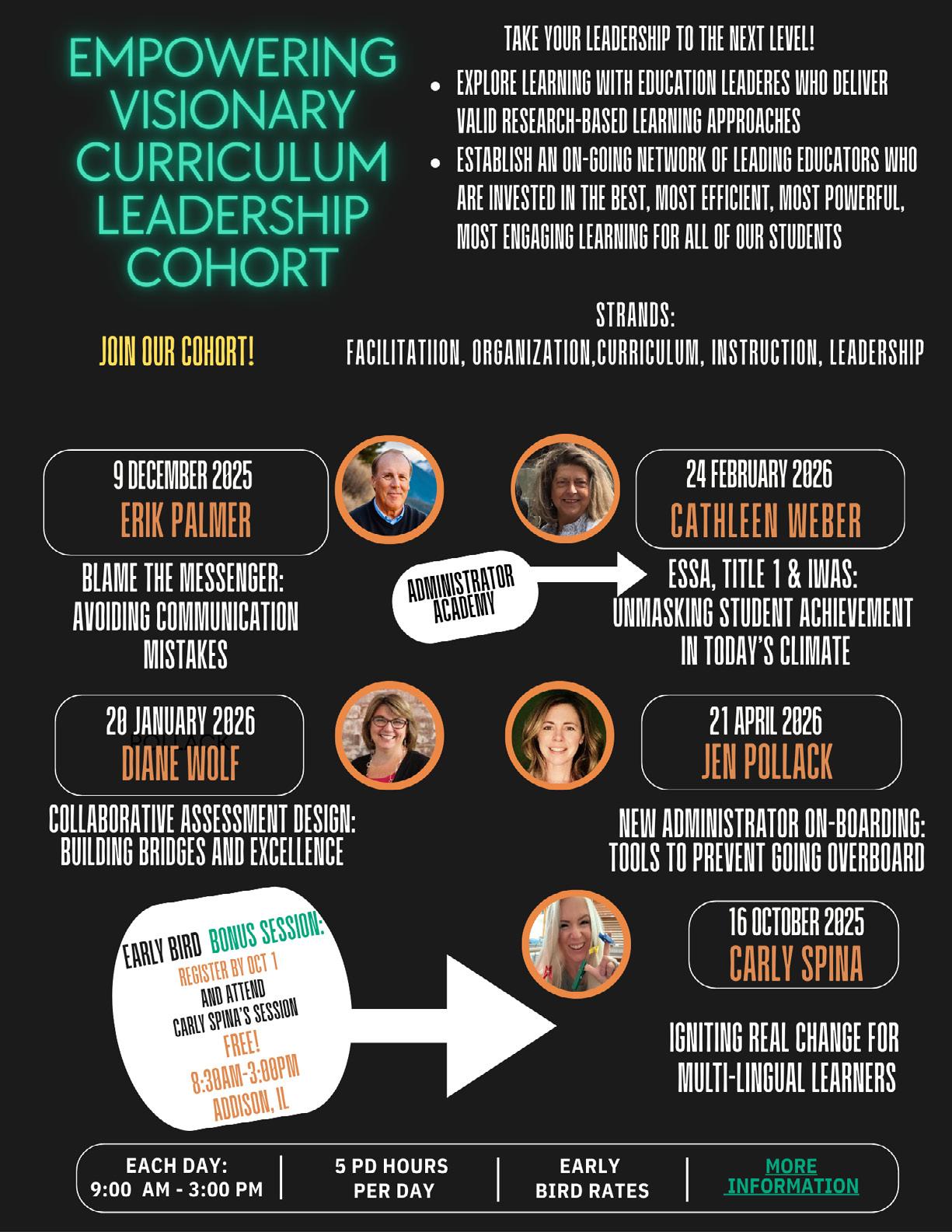



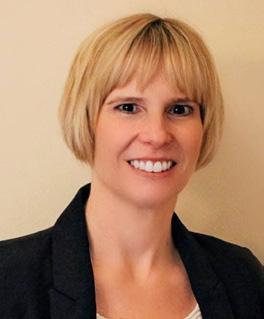
Amy Warke ILASCD President
I Can See Clearly Now: A New Lens on Education
Welcome to this quarter’s journal, where we embrace the theme, “I Can See Clearly Now.” In education, clarity is more than a moment of insight—it is a way of seeing, thinking, and acting that helps us move forward with purpose. In a world marked by rapid change and increasing complexity, clarity is what grounds us. It enables us to pause in the midst of challenges, to step back from the noise, and to rediscover the values and vision that guide our work.
Clarity does not always come easily. It requires reflection, humility, and the willingness to see with fresh eyes. It asks us to question assumptions, to
Amy Warke, President awarke2008@gmail.com
Scott England, Past President esengland@umes.edu
Amy MacCrindle, President-elect amaccrindle@district158.org
Sarah Cacciatore, Treasurer scacciatore@d75.org
Andrew Lobdell, Secretary lobdella@le-win.net
Debbie Poffinbarger, Media Director debkpoff@gmail.com
Ryan Nevius, Executive Director rcneviu@me.com
Bill Dodds, Associate Director dwdodds1@me.com
Task Force Leaders:
Membership & Partnerships
Denise Makowski, Amie Corso Reed
Communications & Publications
Belinda Veillon, Jacquie Duginske
Advocacy & Influence
Richard Lange, Brenda Mendoza Program Development
Jamie Bajer, Heather Bowman, Scott England, Amy MacCrindle, Terry Mootz, Amie Reed, Dee Ann Schnautz, Belinda Veillon, Richmond Burton, Amy Warke, Doug Wood

open ourselves to new perspectives, and to listen deeply to the voices around us. When we find clarity, we gain not only a sharper understanding of where we stand, but also a stronger sense of where we are going. It is this balance of reflection and forward-looking vision that allows both educators and students to thrive.
Seeing clearly also means embracing transformation. Change, when viewed through a lens of clarity, shifts from being a disruption to being an invitation—a chance to grow, to innovate, and to reimagine what is possible. In our schools, classrooms, and communities, clarity empowers us to see potential where once we saw obstacles, and to recognize that every challenge holds within it the seeds of progress.
Just as importantly, clarity reminds us of the support we need to sustain ourselves on the journey. It is not only about big ideas or distant goals, but also about the daily practices, relationships, and
commitments that keep us steady. Clarity helps us align our actions with our values, nurture our own well-being, and draw strength from one another. When we see clearly, we not only chart our own path but also create the conditions for others to flourish.
As you move through the pages of this journal, may you find inspiration that sharpens your vision, challenges that
stretch your thinking, and insights that renew your sense of purpose. Let this issue remind us all that when we choose to see with clarity—both the present moment and the horizon ahead—we discover not only where we are, but also who we can become as learners and leaders.
Amy Warke, Ed.D. President, IL ASCD
- PD 365
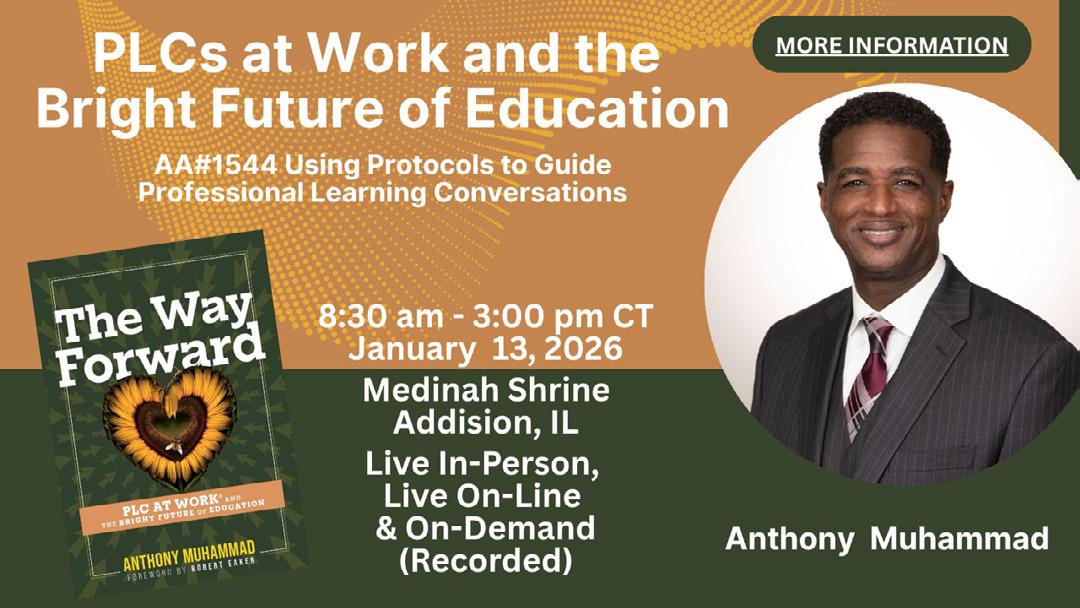
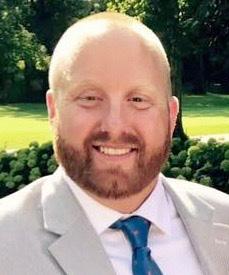
Ryan Nevius ILASCD Executive Director
rcneviu@me.com
As we kick off another fantastic school year, I want to welcome back the dedicated educators across Illinois whose passion leads to meaningful learning experiences for all students. We are grateful for the countless ways you inspire, innovate, and make a difference every day. Cheers to another year filled with endless learning opportunities!
The theme of ILASCD’s fall journal, “I Can See Clearly Now,” feels especially fitting this time of year. Listening to the Johnny Nash classic on Spotify reminds me of the clarity, hope, optimism, and renewal we all crave at the start of a school year. Its lyrics serve as a powerful metaphor for clearing away the clouds, embracing possibilities, and helping students and ourselves thrive.
Building on that theme, we invite you to keep Illinois ASCD in mind as a partner in your professional journey. Together, we can help remove the obstacles in your way, clear the rain, and keep your year feeling like a bright, sunny day.
I’m also thrilled to announce that the clouds have lifted on our Fall Professional Development Calendar and the sunshine is bright! This year’s offerings feature a brand-new event we hope will become an annual favorite:
• When: November 5, 6, 12, and 13
• Time: 9:00 a.m. – 12:00 p.m. each day
• Format: Live and on-demand options to fit your schedule
Vision 365 brings together the most requested topics from last year’s statewide needs assessment, including:
• Math
• PLCs
• Writing
• Burnout
• Literacy
• Restorative Practices
• Absenteeism
• AI in Education
• Grading
• Communities of Belonging
Our speaker lineup is packed with leading voices in education: Anthony Muhammad, Diane Sweeney, Tony Frontier, Dave Nagel, Ricky Robertson, Ali Hearn, Vanessa Vakharia, and many others.
To ensure budgets aren’t a barrier, we’ve launched a Back-to-School Registration Special with affordable rates for individuals as well as small and large groups.
Join us as we reimagine school improvement, together.
We can’t wait to see how Vision 365 and all our fall professional learning opportunities help clear the path for a brighter future in our schools.
Thank you for the work you do every day to inspire and lead. We look forward to learning, growing, and celebrating success alongside you throughout the year ahead.
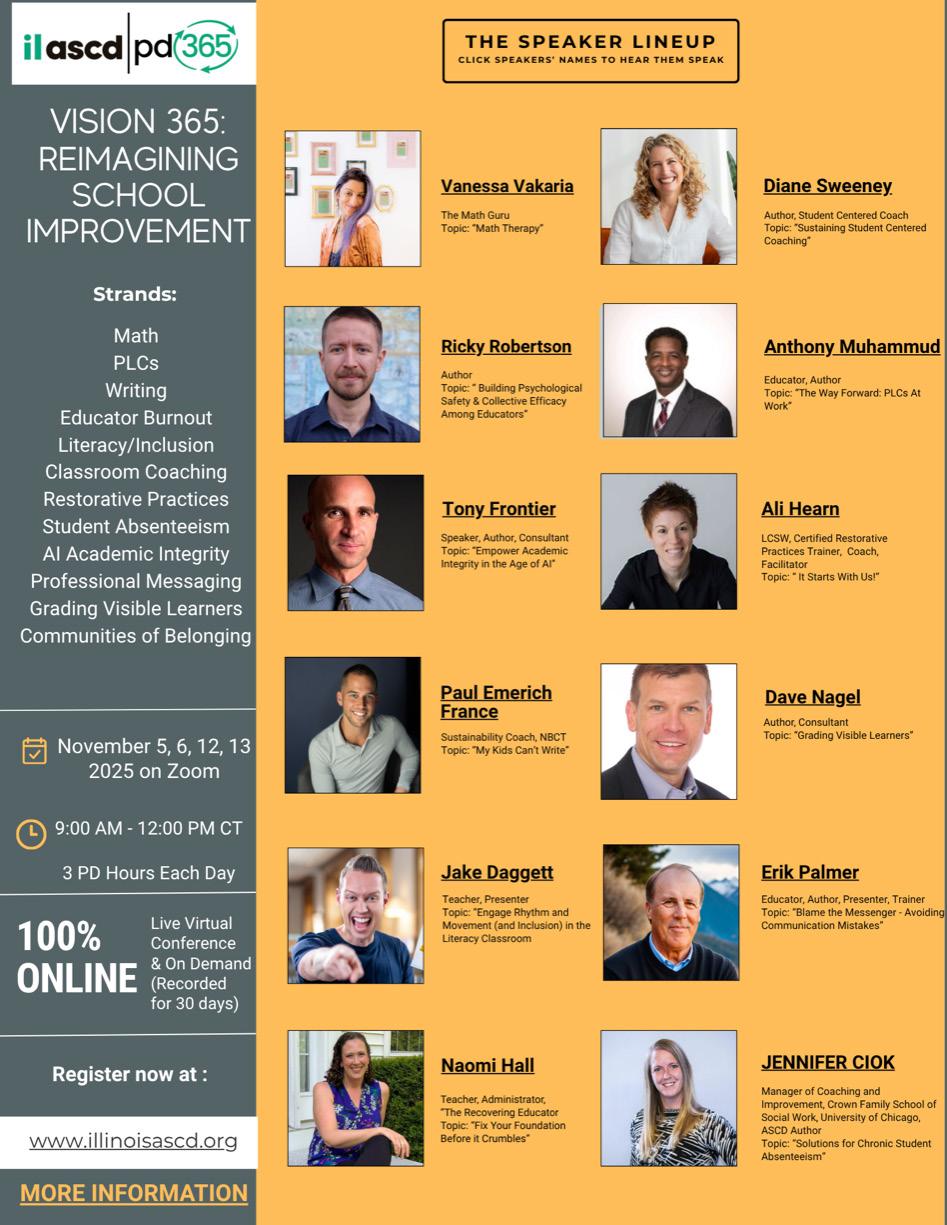
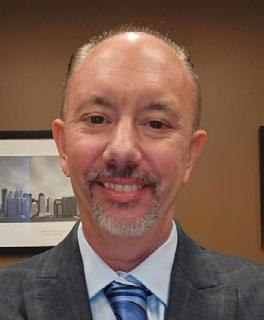
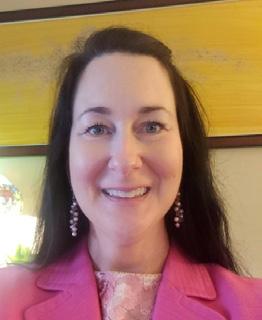
When resources are limited, connection is amplified as our most powerful tool.
Across Illinois, and nationally, teacher shortages have become persistent and systemic, affecting not only general education but also critical supports such as special education, mental health, speech, social work, school psychological, hearing, and vision services (National Center for Education Statistics, Dec. 2024). These shortages strain financial onboarding, standard operating procedures, and delivery of services, particularly for students with disabilities. This article draws upon peer-reviewed research and ASCD-based leadership wisdom to explore the impacts of shortages on school leadership and to share lessons learned and lessons in-progress.
The chronic shortages of qualified special education teachers and related service providers continues to be
a major challenge for Human Resource and Special Education Directors. The demand for special education providers remains very high. This can be attributed to the following factors (Gilmour, MasonWillimas, & Bettini, 2024):
• Limited Applicant Pool
• High Turnover and Impacted Stress and Resilience Rates
• Lack of Support from Administration
• The High Workload Variables for Special Education Providers
student outcomes, teacher morale, and organizational culture, forcing principals to focus more on crisis management than strategic vision (Ingersoll et al., 2018; Creagh et al., 2023; ASCD, 2024).
Effective leadership, especially that which fosters trust and positive culture, plays a critical role in recruiting and retaining teachers and other school-based providers (Nguyen, et al., 2024)). Growing workloads has significant consequences, not only for educator well-being but
Teacher and related service provider shortages may destabilize instruction, staff well-being, and school climate, while also significantly altering principal leadership roles and priorities.
Shortages of special education teachers and related service staff members seemingly lead to negatively impacting staff members and the students (Gilmour, Mason-Williams, & Bettini, 2024). Teacher and related service provider shortages may destabilize instruction, staff well-being, and school climate, while also significantly altering principal leadership roles and priorities (see Table 1 for samples). As some are experiencing, shortages negatively affect
also for student engagement and academic performance (Creagh et al., 2023; Will, 2022; Bettini, 2024). For those supporting learners with disabilities, barriers may include maximum capacity of specialized service providers due to shortages (Bettini, 2024).
In typical times, often leaders may lose track of available external resources. Although already valuable, sharing
resources has become crucial. The Illinois State Board of Education (ISBE) provides a comprehensive suite of Special Education Technical Assistance Projects designed to strengthen success, inclusive practices, and various student access needs; these align with the Whole Child framework. Several align with more than one Whole Child tenet, however for illustrative purposes, one is shared for each as an example.
Regarding the Healthy tenet, ISBE’s Behavior Assessment Training Project (BAT) supports educators in developing culturally responsive Functional Behavior Assessments and Behavior Intervention Plans that enhance emotional wellness (Illinois State Board of Education [ISBE], 2024). Under Safe, the Autism Training and Technical Assistance (ATTA) initiative equips schools with tools for fostering accessible learning environments through strategies for communication, as well as high school to secondary opportunities/ transition planning for students with autism (ISBE, 2024).
To promote Engaged learning, the Illinois Assistive Technology Program (IATP) and Infinitec provide training, evaluations, and assistive technology services that enable students with disabilities to access curriculum and participate meaningfully in academic activities (ISBE, 2024). Another example
is the Autism Professional Learning & Universal Support Project | Home for effective behavioral and communication supports. Ready-made visual supports for engagement, and social-emotional growth are helpful to any educators, and especially to new teachers and teams.
Within the Supported tenet, the Illinois Elevating Special Educators (IESE) Network focuses on mentoring, leadership development, and family engagement, helping retain early-career special educators (ISBE, 2024). Several on-demand free webinars are available to access. The QualityIEP Project provides clear direction, samples, and structure for educators in developing high-quality IEPs. Specifically for Special Education Leadership looking for advancing knowledge and skills as leaders that support programs, the Special Education Leadership Academy focuses on decision-making, communication, continuous improvement process, and resources/technical supports (ISBE, 2024).
Finally, the Challenged tenet is advanced through the Specific Learning Disability (SLD) Support Project evidenced-based and promising practices, real examples of supports, and free trainings. Also, the Early Choices and STAR NET Early Childhood Inclusive Practices, offers resources for approaches, targeted instruction, and early intervention
resources to close achievement and opportunity gaps to foster equitable academic opportunities (ISBE, 2024). Regarding older learners, the IL Center of Transition and Work provides direction and support in self-determination, work place support, and understanding employment pathways, with the aim to improve employment outcomes.
To address staffing shortages and improve educator retention, consider implementing the following strategies:
• Accelerated Pathways. Explore licensed educator fast-track programs to help staff earn certifications more efficiently. Pair this with quality mentoring.
• Internship Opportunities. Offer districtbased placements, with an emphasis on Multilingual Learners (MLL) and Special Education.
• Competitive Compensation. Use financial incentives to attract and retain talent in hard-to-fill positions.
• Consider ISBE Avenues. Utilize teacher vacancy grants available to districts with the highest number of unfilled positions.
• Enhance Working Conditions.
• Establish structured mentor programs.
• Provide targeted support from
Directors, Principals, HR, and Curriculum leaders.
• Implement a comprehensive onboarding plan for new hires.
• Reduce Administrative Burden. Streamline special education paperwork to minimize extensive compliance requirements.
To strengthen recruitment efforts and promote sustainable staffing solutions, adopt a multifaceted approach:
• Diversify Recruitment Channels. Go beyond traditional postings by leveraging social media, connecting with college field experience site managers, and contacting college department chairs directly.
• Strategic Use of Staffing Agencies. Partner selectively with specialized education staffing agencies for short- and long-term vacancies, ensuring clear expectations and active collaboration.
NOTE - these individuals do not fall on the district evaluation schedule, therefore it is crucial to have a plan for providing feedback and support. Staffing agency personnel may or may not be required to attend professional development sessions or complete
after-school activities. Be diligent in a team approach working with HR and the Chief School Business Official so that someone is thoroughly appraised of the staffing agency contract details.
• Flexible Staffing Solutions. Hiring substitutes and alternative staff may
angle, has provided some improvements. What leaders are living right now may involve several main areas: (a) Finance: Increased costs from contracts and recruitment; (b) Vision: Balancing inclusivity with limited resources, (c) Service Delivery: Ensuring equitable access for students with disabilities; (d) Culture
Educator shortages are policy challenges as much as operational ones.
be a viable solution. This can impact the districts’ substitute pool. The use of substitutes for special education providers requires that a certified special education staff member must lead (i.e., develop/write annual goals, develop lesson plans, and provide progress monitoring support for the substitute, who cannot directly complete such tasks).
• Explore Virtual Options. Evaluate the benefits and limitations of using thirdparty vendors or virtual educators to fill service gaps.
Educator shortages are policy challenges as much as operational ones. Engaging with ISBE and state-wide professional organizations to learn and secure systemic solutions, and explore every
and Climate: Building morale during high turnover (Will, 2022); (e) Student Outcomes: Shortages directly affect student engagement and performance (Darling-Hammond, et al., 2023).
Although challenges remain, leaders and educators power through. Crucial lessons learned/lessons in-progress consistently emphasize connection and clarity. To build capacity, save time from manually learning about resources, and establish connections, the following list includes ideas for new leaders or veteran leaders looking for new ideas.
The ASCD Educational Leadership collection on teacher shortages provides research-driven recommendations for school leaders facing these challenges (ASCD, 2024). Regional
Offices of Education (ROEs), and ISBE professional development and technical assistance supports, such
Assign internal liaisons to onboard and integrate contracted professionals for continuity and quality assurance.
as the QualityIEP Project, and the SLD Project offer onboarding assistance ideas, professional development, and collaborative options. Additional supports include Illinois professional organization networking, and targeted professional learning, such as ILASCD, IAASE, ILPP, IASBO, and IASA.
For contracted professionals such as speech-language pathologists or school psychologists, establish explicit agreements on onboarding, quality monitoring, and integration into school culture. Create contingency plans for performance feedback and support, as many contracted providers operate outside PERA evaluation systems.
Develop comprehensive protocols for early screening of student needs, ensuring timely access to health, behavioral, and academic supports.
Centering leadership decisions around the Whole Child framework (ASCD, 2013) promotes sustainable student success and educator support. For example, begin with the following ideas:
• Healthy: Establish a process to screen students for health and social/ emotional needs.
• Safe: Establish a process to communicate critical information to ensure safe learning environments.
• Engaged: Establish a process to build capacity for teams to maintain student participation and for leaders to connect directly with families (e.g., ParentSquare).
• Supported: Establish a process to offer professional development and wellness supports for practitioners, including a schedule for veteran and new educators’ needs.
• Challenged: Establish a process to
acquire, build fluency, maintain, and generalize professional learning that is evidenced-based and manageable addressing rigorous academic standards, and proven specialized supports.
In typical times and in times of scarcity, connection is key. Leaders who seek local, state, and regional supports, foster partnerships, and advocate for promoting connection and clarity in processes, may better transform challenges. With a Whole Child Approach and connection as your vision, consider:
• In what ways can we connect with the resources available?
• What is working well and where do I need support?
• Have I given myself credit and celebrated all that I have accomplished (individually and collaboratively) in contributing to access, processes, and student success?
• Have I acknowledged where there are opportunities for growth?
• What examples can I share for families to connect healthy, safe, engaged, supported, challenged progress?
ASCD, (2007). Whole child approach to education [tenets]. https://files.ascd. org/staticfiles/ascd/pdf/siteASCD/ publications/wholechild/WC-OnePager.pdf
ASCD, (2013). The whole child approach. https://www.ascd.org/whole-child
ASCD, (2024). Addressing teacher shortages: Leadership strategies. Educational Leadership, 81(3), 1218. https://information.ascd.org/ january-2024-el-topic-addressingteacher-shortages
Bettini, E. (2024). Addressing special education staffing shortages: Strategies for schools [Brief]. EdResearch for Action. 55015-EdResearch-SpecialEducation-Staffing-Brief-31FINAL-1-1.pdf
Creagh, S., Thompson, G., Mockler, N., Stacey, M., & Hogan, A. (2023). Workload, work intensification and time poverty for teachers and school leaders: a systematic research synthesis. Educational Review, 77(2), 661–680. https://doi.org/10.1080/0 0131911.2023.2196607
Darling-Hammond, L., DiNapoli, M., Jr., & Kini, T. (2023). The federal
Table 1 Summary Key Issues, Strategies, and Resources
Key Issues Strategies & Resources
Teacher Shortages Across Specializations
Fragmented Onboarding & Training for Contracted Providers
Financial Strains Due to Staffing Gaps
● Partner with Regional Offices of Education (ROEs) and cooperatives to explore shared staffing models.
● Consider existing projects such as the SLD Project and ISBE programs for professional pipelines.
● Use ASCD’s resources on retaining educators (ASCD, 2024).
● Develop clear onboarding protocols.
● Establish explicit agreements with outside providers on training and supervision.
● Use mentors or liaisons to integrate specialists into school culture.
● Seek grants for high-need areas, such as ISBE Teacher Shortage licensure opportunities.
● Explore cooperative purchasing and staffing agreements to reduce costs.
● Seek existing resources for training, such as the ISBE Technical Assistance projects.
Student Outcomes and Learning Gaps
● Prioritize equitable service delivery to protect academic growth.
● Provide targeted interventions, UDL, differentiated instruction, assistive technologies, and free resources from the ISBE Technical Assistance projects.
● Collaborate with ISBE and professional associations for training and resources.
● Access ASCD’s guidance on maintaining positive culture during staffing crises.
role in ending teacher shortages. Learning Policy Institute. https://doi. org/10.54300/649.892
References
Gilmour, A., Mason-Williams, L., & Bettini, E. (2024). How the special education teacher shortage affects students with SLD. Learning Disabilities
ASCD, (2007) Whole child approach to education [tenets] https://files.ascd.org/staticfiles/ascd/pdf/siteASCD/publications/wholechild/WC-One-Pager.pdf
Association. [U.S. Department of Education Grant R324C240002]. https://ldaamerica.org/howthe-special-education-teachershortage-affects-students-with-ldand-what-to-do-about-it/
Illinois State Board of Education. (2024). Special education technical assistance projects. https://www.isbe.net/ Pages/Special-Education-TechnicalAssistance-Projects.aspx
Ingersoll, R., Merrill, E., Stuckey, D., and Collins, G. (2018). Seven trends: The transformation of the teaching force [updated October 2018]. CPRE Research Reports. https:// repository.upenn.edu/cpre_ researchreports/108
Nguyen, D., See, B. H., Brown, C., & Kokotsaki, D. (2024). Leadership for teacher retention: exploring the evidence base on why and how to support teacher autonomy, development, and voice. Oxford Review of Education, 1–21. https://doi.org/10. 1080/03054985.2024.2432635
OpenAI. ChaptGPT4.0 [for formatting, table, crosschecking, alignment].
Will, M. (2022). Stress, burnout, depression: Teachers and principals are not doing well, new data confirm. Education Week. https://www.
edweek.org/teaching-learning/ stress-burnout-depressionteachers-and-principals-arenot-doing-well-new-dataconfirm/2022/06
Heath Brosseau is a transformative and servant leader. As Director of Pupil Personnel Services, and program mentor to administrators of special education interns, he brings decades of experience in mentoring new and veteran faculty, leading departments, developing programs, navigating the unexpected, and advancing continuous improvement beyond compliance. Contact Info: hbrosseau@ isd109.org; heathbrosseau@gmail.com
Andrea Dinaro Ph.D., is a Professor of Special Education at Concordia University Chicago, is the Chair of the Division of Curriculum, Technology, and Inclusive Education (CTIE), and Program Leader for special education related doctoral programs. Research interests include assistive technology, disability in the curriculum, specialized curriculum and instruction, special education leadership, and special education preparation program improvement. Contact: andrea.dinaro@ cuchicago.edu

Self-reflection is often spoken about in teacher education programs and faculty development workshops, but in practice, it is far more complex than simply asking, “What could I have done better?” For educators, particularly those navigating emotionally
...sometimes the barrier to clarity is not the student, the material, or the classroom dynamics. It is ourselves.
and intellectually charged topics, self-reflection is a discipline that requires humility, vulnerability, and adaptability (Nduagbo & Cassle, 2023). It involves the ability to pause, assess not just what we are teaching but how we are showing up as teachers, and recognize that sometimes the barrier to clarity is not the student, the material, or the classroom dynamics. It is ourselves.
I say this not to point fingers outward. I say this because I have had to do this work inwardly for most of my life. As a trained therapist, you might assume self-reflection comes naturally to me. In some ways it does. In other ways, it is
as difficult and humbling as it was when I first began learning about it in fifth grade.
I still remember the day vividly. I had just struggled through a math problem, and my frustration was written all over my face. I was someone who felt intense pressure to get it right the first time. When that did not happen, anxiety would creep in and cloud everything else. My teacher could have moved on, but instead, she paused and asked me a simple yet profound question: “Can you tell me what part of the problem you didn’t understand, and what you might try differently next time?” At the time, I did not have the full vocabulary to explain my frustration or fear, but I knew something important had just happened. She had seen me, not just the mistake. And in that moment, I began learning how to see myself too (Nduagbo & Cassle, 2023).
the students became resistant, not just to the content but to the way it was being taught. I was met with persistent challenges and what felt like a lack of collaboration in the learning process. Their questions did not seem intended to
I asked myself how I could reframe my approach, not to avoid resistance, but to meet it with compassion.
promote dialogue. They felt defensive, and at times, dismissive. It was tempting to frame this as their problem, not mine. But that fifth-grade lesson reminded me otherwise. Research within the Whole Child framework underscores that students learn best in environments that are physically and emotionally safe for students and adults, otherwise they cannot fully engage or concentrate.
That memory returned to me recently in a very different setting. I was teaching a graduate-level multicultural psychology course. The class included difficult data, material that required students to confront systemic inequities and examine their own social positioning. Some of
After class, I returned to some of my graduate texts (Myllykoski-Laine, 2024). I pulled out Sue and Sue, a foundational resource I had once used to help clients explore their internalized conflicts. Suddenly, it was guiding me back to myself. The message was clear. Selfreflection is not just about hindsight. It is about responsiveness in real time. I asked myself how I could reframe my approach, not to avoid resistance, but to meet it with compassion. I shifted from
a didactic style to a more dialogical one. At the next class, I began with a personal story. I shared transparently why this material matters to me. Then I invited the students to speak honestly about what was showing up for them. This shift aligns with the Whole Child tenet that active engagement and a sense of connection to the school and broader classroom community can transform learning dynamics. This was not to debate the data, but to examine how it was landing emotionally and intellectually.
The change was subtle, but powerful. It did not eliminate resistance overnight, but it transformed the energy in the room. The space opened. Students began to reflect out loud, not only on the material but on their reactions to it. That clarity was not achieved through stronger arguments or polished slides. It came through self-reflection. By reframing my approach to foster dialogue rather than avoid resistance, I was living the Whole Child principle of challenging students academically while preparing them as critical thinkers in a global environment (Constanza, 2019).
In a world that moves quickly and prizes certainty, reflection can feel inefficient or even indulgent. But it is what allows us to teach with integrity. It is what allows us to see clearly. Not just the curriculum or the outcomes, but ourselves and the
students in front of us. I remain grateful for the teachers who modeled reflection for me, for the authors who reminded me to return to it, and for the students who challenge me to practice it more deeply every time I teach.
ASCD, (2007). Whole child approach to education [tenets]. https://files.ascd. org/staticfiles/ascd/pdf/siteASCD/ publications/wholechild/WC-OnePager.pdf
CDC. (2024). Whole school, whole community, whole child (WSCC). https://www.cdc.gov/whole-schoolcommunity-child/about/index.html
Costanza, V. (2019). The whole child bridge. https://teachingstrategies. com/blog/the-whole-child-bridgelinking-tenets-to-developmentaldomains
Myllykoski-Laine, P. (2024). Self-reflection supporting teaching and well-being in higher education. Reflective Practice, 25(5), 1–15. https://doi.org/10.1080 /14623943.2024.2376784
Nduagbo, S. O., and Casale, C. (2023). Reflective practice and preservice teachers’ professional growth:
Impacts on self-efficacy. Experiential Learning and Teaching in Higher Education, 6(1 - March), 56–66. https://files.eric.ed.gov/fulltext/ EJ1422264.pdf https://doi. org/10.46787/elthe.v6i1.3555
Dr. Israel Espinosa is a humanistic leader and transformative educator dedicated to fostering academic excellence, equity, and integrity across higher education. As Chair of the Humanistic Psychology
Department at Saybrook University, he brings decades of experience in mentoring doctoral students, developing interdisciplinary programs, and advancing inclusive pedagogical practices. His leadership is rooted in compassion, clarity, and a deep commitment to empowering learners to think critically, live authentically, and engage meaningfully with their communities.
Contact: iespinosa@saybrook.edu
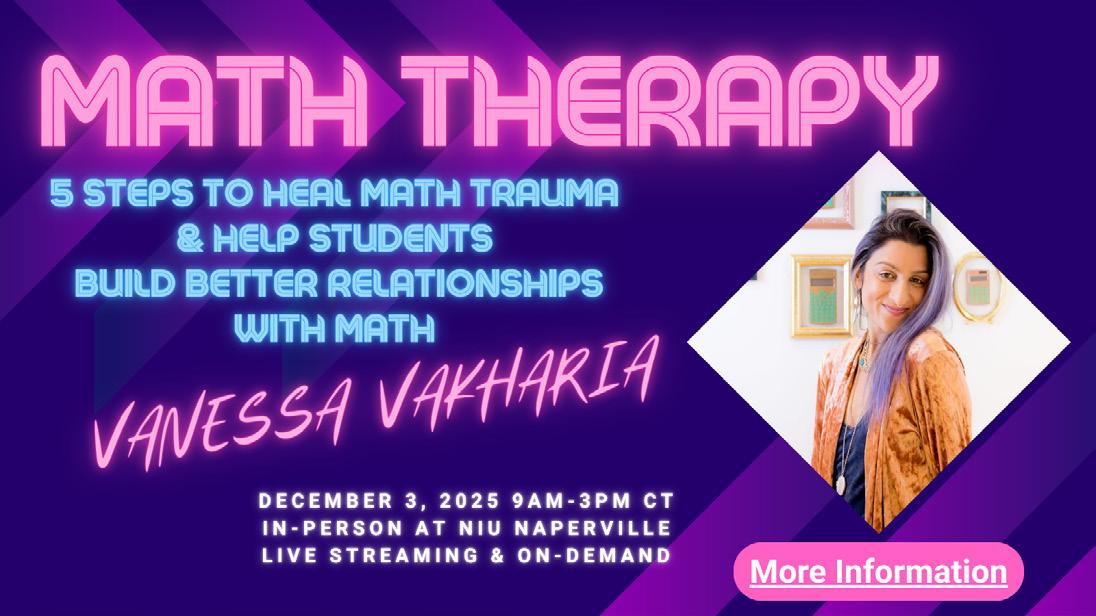
John Hattie, Douglas Fisher, Nancy Frey and John Taylor Almarode
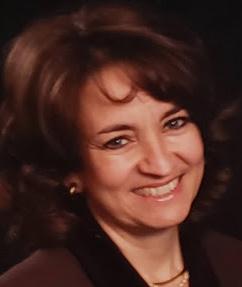
Review by Belinda Veillon
The Illustrated Guide to Visible Learning: An Introduction to What Works Best in Schools, authored by John Hattie, Douglas Fisher, Nancy Frey, and John Taylor Almarode, is an excellent resource for any educators who desire to enhance their practice utilizing robust, evidence-based strategies. The Illustrated Guide, published by Corwin Press in 2024, incorporates John Hattie’s research, which is based on 2,100 meta-analyses and 130,000 studies involving more than 300 million students. In conjunction with authors Doug Fisher, Nancy Frey, John Almarode, and illustrator Taryl Hansen,
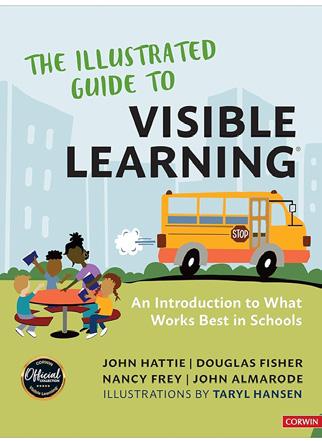
Visible Learning has been translated into an accessible, visually engaging guidebook. The goal of which is to make the foundational goals of Visible Learning accessible to educators.
The Illustrated Guide is based on four big ideas that serve to connect Hattie’s research findings together: climate first, learning second, achievement third; students should drive their learning; know thy impact; and collective responsibility for learning. In addition to the four big ideas, there are targeted sets of mindframes for learners, teachers,
leaders, family/caregivers, belonging, identities, and equity that can be used as self-assessments for determining strengths and providing guidance for where to begin an implementation journey toward more effective practices. To support the journey, The Illustrated Guide is divided into eleven signature practices: classroom and school climate, teacher clarity, phases of learning,
to absorb ‘chunks’ of related information that can then be digested in conjunction with a set of related chunks that support implementation. For those desiring additional explanations and more indepth background research to support the strategies, there is Visible Learning: The Sequel (2023). The structure is based on concise summaries that are organized into meaningful sections and chapters.
The selection of high-impact strategies included is a ‘just right’ launch into bringing these practices into action within any learning environment.
teaching students to drive their learning, teaching with intent, practice and over-learning, feedback, the power of the collective, learning learning, implementation, and evaluative thinking. These signature practices are elaborated through the use of key influences, implementation guidance, checklists, and organizers, bringing Visible Learning from concept to practice.
The best feature of this book is its accessibility. The selection of high-impact strategies included is a ‘just right’ launch into bringing these practices into action within any learning environment. The format of The Illustrated Guide to Visible Learning is reminiscent of a professional graphic novel, which allows the reader
It is an excellent reference guide for specific details related to the influences.
While one track of my mind was reading The Illustrated Guide to Visible Learning, the other tracks of my mind were focusing on its use with educators. It would make an excellent text for a professional book club. If being read by a whole staff or in groups, utilize a workshop model differentiated by educator capacity. Additional salient features include:
• Non-linear structure: The Signature Practices sections can be implemented in the order that best matches the goals and needs of any educator, classroom, and/or school.
• Terminology: The Illustrated Guide to Visible Learning high impact strategies provide terminology that teachers can use with their students.
• Practical Tips, Models, and Dialogue: Throughout the book are provided that teachers can use to support their students’ learning dispositions
• Enhanced Design Features: The arrangement of texts, illustrations, and graphic organizers is key to The Illustrated Guide’s being accessible, actionable, and motivational for teachers and leaders.
I recommend The Illustrated Guide to Visible Learning as an essential professional resource for any educator who desires to bring high-impact strategies alive in their daily learning environment, whether within a professional learning community, a classroom, or a school.
Belinda Veillon has served and continues to serve in education as a teacher, gifted program coordinator, building administrator, and Director of Curriculum. She has been instrumental in the development of district-wide programs including school improvement, MTSS, gifted, inclusion; she has written and manages federal and state grants. Belinda is an active member of the Board of Directors of PD365 (formerly IL ASCD), having most recently served as Past President. Belinda is the Affiliate Director of Illinois Future Problem Solving.Referred to as a “squiggle” because of her ‘outside of the box thinking’; she is often able to envision the impossible as a reality. Her inspiration comes from her ability to make connections with people, concepts, and projects.
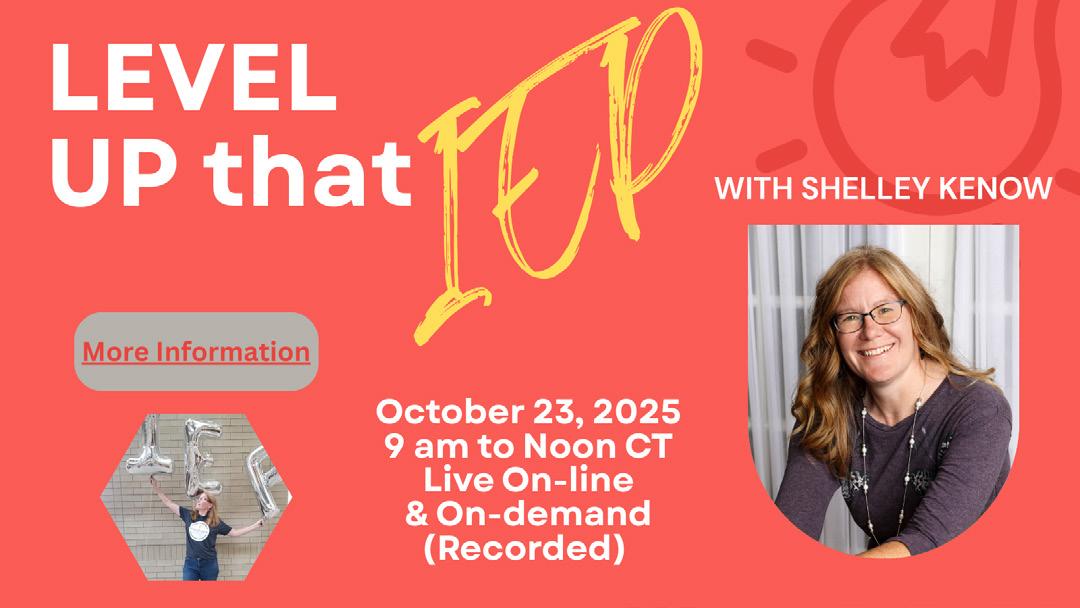
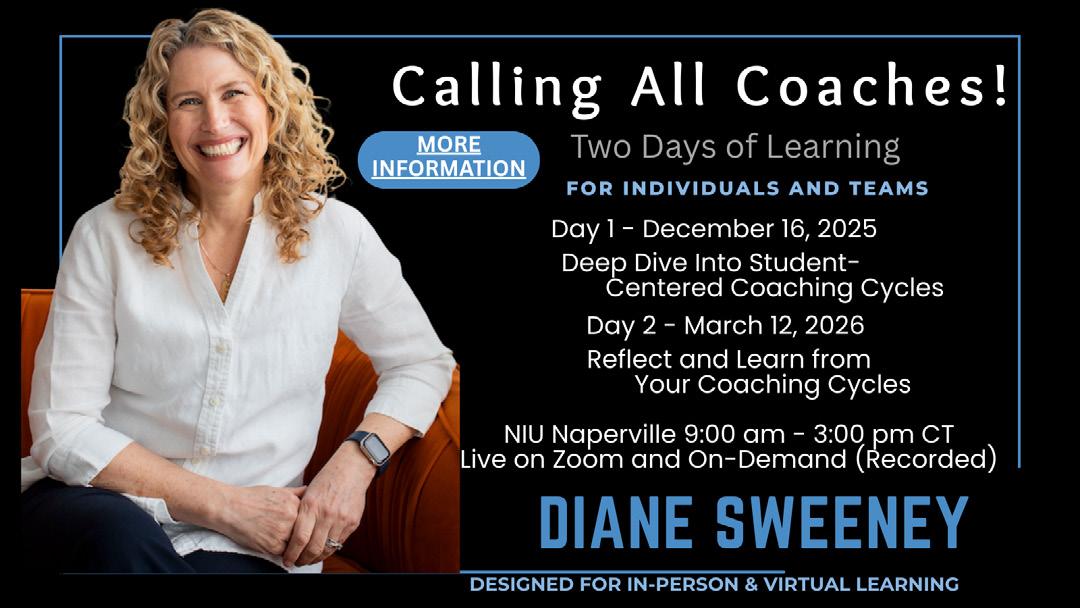
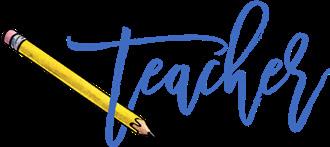
Making sure you understand what your students need to learn, and that you can identify how they will know that they learned it. READ MORE...
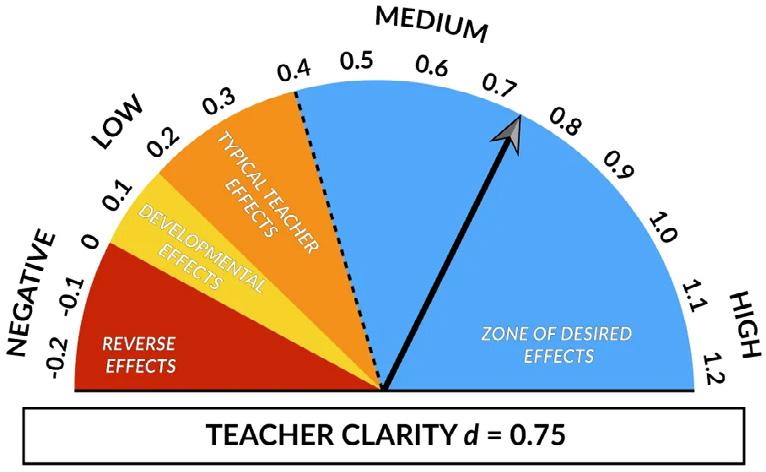
There are a number of ways you as the teacher can clearly articulate the objective of the lesson. READ MORE...
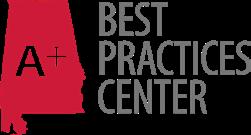

THROUGH
Clear understanding doesn’t come from a teacher’s presentation of information—it evolves through students figuring out what they are learning, together.. READ MORE...
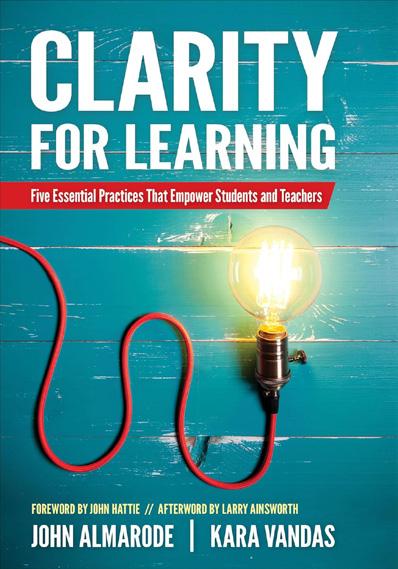
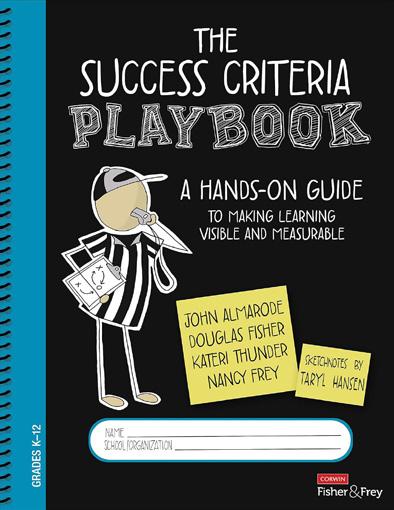
Click the covers to view on Amazon.

Strengthen your team’s capacity for data-driven dialogue with a tool built for clarity and coherence. READ MORE...
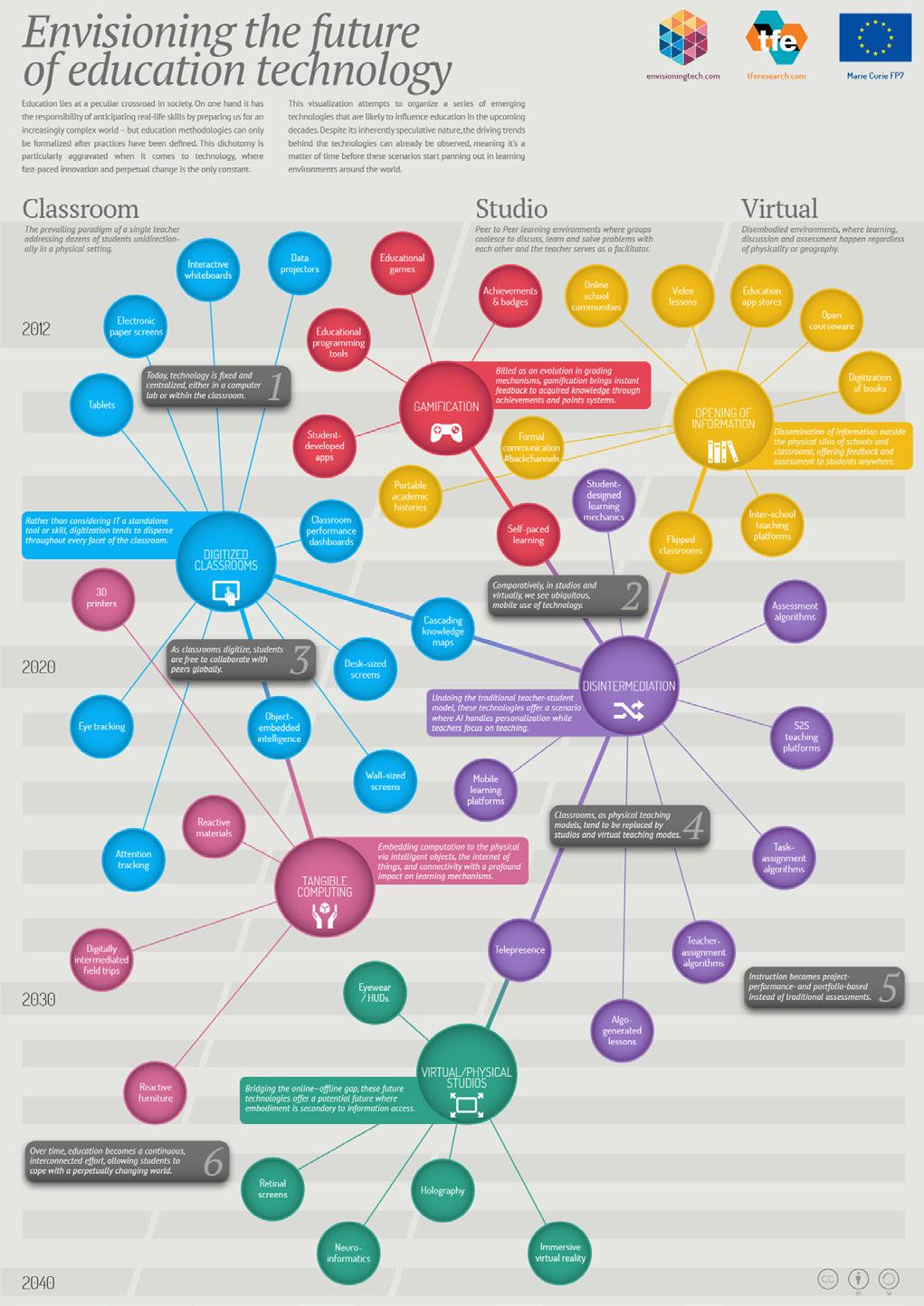

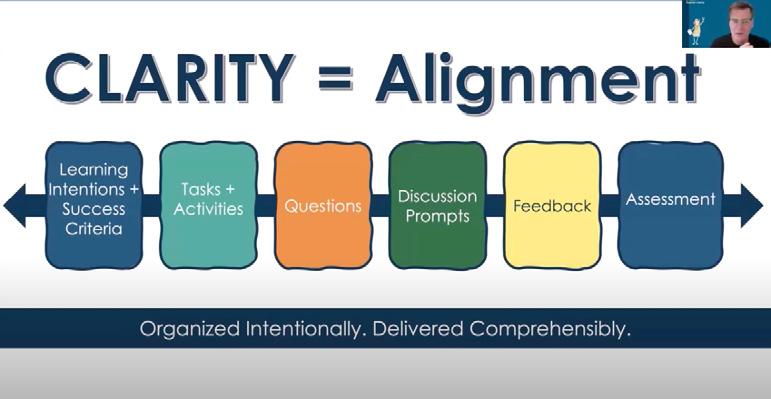
Alignment, alignment, alignment. WATCH THE VIDEO
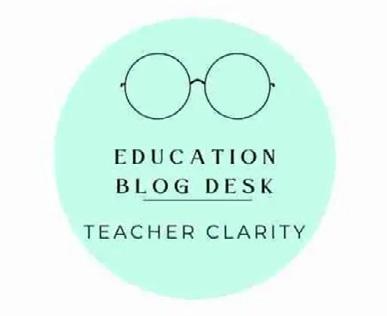
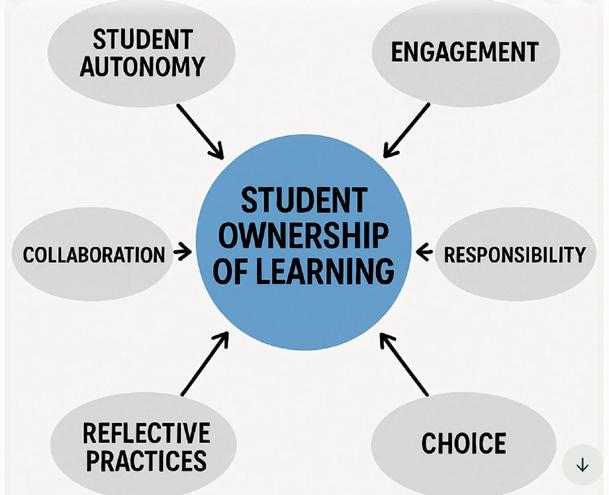
Students take responsibility for their learning process, set goals, make decisions, and monitor their progress with course content. READ MORE...

Four years ago, I looked in the mirror and no longer recognized myself. The vibrant, energized, and full-of-life educator-mom-wife seemed gone, and instead, I saw a worn-out and exhausted version of myself.
At the time, I was teaching in a college of education at a local university. It was my third year working full-time in higher education and my 17th year teaching. Ever since I started my career as a high school English teacher, I thought, “Some day, I might want to teach teachers.”
Here I was doing just that. In my mind, “I had made it”: I had taught high school for over a decade, coached multiple youth sports, stepped into school leadership roles, pursued a master’s degree and then my doctorate, and had landed the “dream job.” I was teaching bright and enthusiastic young people about how to teach and observing them in their novice and student teaching placements. I loved the classes I was teaching and felt like I was making a difference in their lives as future educators.
However, when I visited local teachers' classrooms to watch my college students teach, I noticed something
else, too. The exhaustion. The giving of oneself to one’s job. The wearing down of one’s mindset year after year when we pour everything into our classrooms, our students, and our school community. The secondary trauma of supporting students who come from a variety of backgrounds and home lives.
disapproval. A few years prior, I heard our new school district superintendent during our opening day of the school year tell an auditorium full of my colleagues:
They were hearing horror stories about teaching from those in the field, versus encouragement.
“My daughter told me she wanted to be a teacher. I told her, ‘Don’t do it.’”
I not only saw it, but I heard it in conversations with excellent, veteran teachers who would tell me things like this: “I’ve been teaching for over a decade. I don’t know how much longer I can.” “This job isn’t the same as when I started, and I feel like I’m barely surviving.” “It’s really hard to be an excellent teacher these days.”
For years, I also heard rumblings from my college students that teachers in their placement schools would “warn them” about the teaching profession. Some even urged them to “get out before it’s too late,” causing my college students to question whether they had chosen the right path to become an educator. They were hearing horror stories about teaching from those in the field, versus encouragement. Some were even pursuing a teaching degree despite their parents’
These experiences—of my college students, colleagues, and teachers across the state—in addition to my personal experiences, made me realize that something needed to change in my life and how we support educators.
From the very beginning of my career, I believed that being a “good teacher” meant giving all of myself to the job: late nights at school planning, weekends filled with grading and coaching youth sports, and summers spent preparing for the next school year. It’s just what you do, especially in the initial years of teaching.
Once I had children, I learned to put necessary boundaries in place between work hours and family time. I stopped coaching so that I could spend evenings at home and on the weekends focusing on my family. Even during my doctoral program, I had healthy boundaries.
However, due to the stress of doctoral work on top of motherhood, I developed unhealthy habits that I used to cope with the stress. Late evenings and little sleep due to working on my dissertation, having a drink “to take the edge off,” eating easyto-grab and highly processed foods, and a lack of daily movement due to the hours of reading, researching, and writing.
the universe has a sense of humor, she was also potty training, so I often took meetings with the camera and sound off while I sat on the bathroom floor. Mentally, I just pushed through. Emotionally, I had to keep it together.
With the move to one-to-one technology, teaching expectations, new district initiatives, curriculum changes, etc., it’s hard to balance work and life unless you intentionally do so.
Physically, I sat behind my desk all day and late into the evenings, catching up on emails, preparing for class, and recording lectures.
Those unhealthy habits continued post-graduation with the new stress of working in higher education, but I still had boundaries. Family time was important to me.
Then COVID hit. That’s when all boundaries and work-life balance disappeared. I was teaching college courses at home and leading meetings, while also helping my two elementaryaged children with their virtual classes and their schoolwork. I kept my threeyear-old entertained while I logged into department meetings and held live, virtual classes. Oftentimes, she’d make an appearance, climbing on my lap to pretend to do my makeup. And because
When we went back to work and into classrooms, the former boundaries I had in place didn't magically reappear. It’s as if work and life blended together without any separation. And this continued for years, until I looked at myself in the mirror and decided it was time to change.
While my story reflects my own life experiences, for many educators, setting boundaries and work-life balance has also been a challenge (Doan et al., 2024). With the move to one-to-one technology, teaching expectations, new district initiatives, curriculum changes, etc., it’s hard to balance work and life unless you intentionally do so.
Like so many educators, year after year, I slowly lost touch with the things that once brought me joy outside of the classroom—connection with my children, presence with my family, and a sense of balance in my own mind, body, and spirit.
What I realized in that moment of looking in the mirror was this: losing oneself doesn’t mean you can’t find your way back. The first step was acknowledging that change was needed, and the next step was a step forward in the right direction.
I started to work on my physical wellness first because I found myself on the couch most afternoons, absolutely exhausted. This wasn’t just “the first week of school, teacher tired”; I was completely drained, day after day. I worked with a nutrition and fitness coach to help me examine my current habits and make small shifts each week to help me nourish my body. I focused on what I was eating, drinking, how I was moving my body, and my sleep. I made sure to drink enough water, move my body daily through morning and evening walks, and began to put boundaries in place so that I could “shut down work,” spend time with my family, and get a good night’s sleep (Aguilar, 2018; Tate, 2022). I learned that if I wanted my body and mind to perform a certain way, I had
to fuel it with food and movement that energized me, versus drained me.
I examined my daily routines so that I could put systems in place that supported me. My stress level was at an all-time high, so I began to start my day in a more peaceful state. I woke up 10 minutes early for quiet reflection before my children woke up. Four years later, it is still how I start my morning. I call it my “10-Minute Power Practice.” I brain dump, set three intentions for the day, and express gratitude–all research-based strategies to support my mental and emotional health (Strom, 2024). I also built in things that “filled my cup” on a daily basis: connecting with my children and spouse, walking in the morning and evenings, reading before bed–things that I had sacrificed before became a priority once again.
Managing my stress helped to boost my resilience and change the negative habits I had developed. This included taking deep breaths before responding to emails, standing up to stretch before starting a new work task, walking to the water fountain to clear my mind before a meeting or starting class, or going on a distraction-free walk after work. I also became more self-aware of my emotions throughout the day and asked myself, ‘How am I feeling? Why might I be feeling this way? And what can I do about it?’
In Onward: Cultivating Emotional Resilience in Educators, Aguilar explains, “With emotional intelligence, we can register our physical state and learn strategies to regulate our physiological response so that we can return to a clearer thinking state” (p. 57). I became more aware of my emotional state
school communities, teachers, and students can thrive (Aguilar, 2024; Aguilar, 2018; Tate, 2019).
At the school district level, socialemotional initiatives, programming, and professional development can support faculty and staff to help individuals
Professors can encourage setting healthy boundaries, modeling how they do so themselves, and talking about the challenges and successes of doing so.
as I practiced different mindfulness strategies, like becoming aware of my emotional cycle and the conditions under which my emotions developed, focusing on my breath, sitting in stillness, and then deciding the best next step for that situation (Aguilar, 2018; Hanson, 2020). Over time, these strategies became part of my day.
With rising teacher burnout, lack of newteacher mentorship, and overwhelming responsibilities pushing educators to the brink (Diliberti & Schwartz, 2023; Dill, 2022; Marken & Agrawal, 2022), it is essential that we support the whole teacher, not just the role they play in the classroom. As educators, we must remember that our wellness isn’t optional—it’s foundational. When we support the whole teacher,
At the university level, department initiatives and teacher education coursework can focus on supporting students and their overall well-being. Wellness initiatives can be encouraged through programming, events, and mentorship of teacher candidates (Ireland et al., 2024). Professors can encourage setting healthy boundaries, modeling how they do so themselves, and talking about the challenges and Teacher Wellness (cont.)
establish boundaries (Stevens, 2024), create healthy habits at work and at home (Tate, 2019), and do things that bring them joy each day (Aguilar, 2028). School administration and teacher leaders can model what it looks like to hold healthy boundaries, listen to teachers’ needs, and provide time for teachers to focus on teaching and learning.
successes of doing so. Coursework can encourage students to read about and practice wellness habits and work on resilience strategies as they develop their teacher identity.
Our schools cannot function without healthy, fulfilled adults who are taking care of our students. The “collective wellbeing” of educators and school leaders matters more now than ever before (Aguilar, 2024, p. 2). In my own home, classroom, and in the schools I’ve had the privilege to work in, I have experienced firsthand what Aguilar states here: “Students cannot thrive unless the adults who spend all day with them are also thriving; teachers cannot thrive unless the coaches and administrators who support them are also thriving” (p. 2). Teacher wellness must be a priority because it’s foundational to every classroom and every school.
Aguilar, E. (2024). Arise: The art of transformational coaching. John Wiley & Sons.
Aguilar, E. (2018). Onward: Cultivating emotional resilience in educators. John Wiley & Sons.
Diliberti, M.K, & Schwartz, H. L. (2023). Educator turnout has markedly increased, but districts have taken actions to boost teacher ranks. RAND Corporation. https://www.rand.org/pubs/ research_reports/RRA956-14.html
Dill, J. (2022, June 20). School’s out for summer and many teachers are calling it quits. The Wall Street Journal. https://www.wsj.com/articles/ schools-out-for-summer-andmany-teachers-are-calling-itquits-11655732689
Our schools cannot function without healthy, fulfilled adults who are taking care of our students.
The lesson I’ve learned is this: our individual wellness must come first. Then, collectively, we must move forward to do better for ourselves, our families, our students, and our school communities so that we can help our students to become thriving, healthy individuals themselves.
Doan, S., Steiner, E.D., & Pandey, R. (2024). Teacher well-being and intentions to leave in 2024: Findings from the 2024 state of the American teacher survey. RAND Corporation. https://www.rand.org/pubs/ research_reports/RRA1108-12.html
Hanson, R. (2020). Resilient: How to grow an unshakable core of calm, strength, and happiness. Harmony.
Ireland, A., Hill, L., & Twomey, S. (2024). Preservice teachers and school health and wellness. In Education, 29(3): 77-93. https://www.researchgate. net/publication/386065033_ Preservice_Teachers_and_School_ Health_and_Wellness
Marken, S., & Agrawal, S. (2022, June 13). K-12 workers have highest burnout rate in U.S. Gallup News. https://news. gallup.com/poll/393500/workershighest-burnout-rate.aspx
Stevens, G. (2024). Beat teacher burnout with better boundaries: The secret to thriving in teaching without sacrificing your personal life. Red Lotus Books.
Strom, K. (2024). Start your day strong: “10-Minute Power Practice.” drkristenstrom.com. https://www. drkristenstrom.com/journal/startyour-day-strong-10-minute-powerpractice
Tate, M. L. (2019). Healthy teachers, happy classrooms: Twelve brain-based principles to avoid burnout, increase optimism, and support physical wellbeing (Manage stress and increase your health, wellness, and efficacy). Corwin.
Dr. Kristen Strom, Ph.D., is a keynote speaker, published author, and awardwinning leader in education and agriculture. She began her career as a secondary language arts teacher and has taught and mentored preservice teachers at Illinois State University, Knox College, and Bradley University. She has presented at state and national conferences, including the National Council of Teachers of English and the Illinois Association of Teachers of English, and has been published in peer-reviewed journals and edited book collections. She currently serves as the Director of Education and Agriculture Outreach for an Illinois State Representative and consults with Illinois Regional Offices of Education and schools on professional development focused on wellness, curriculum, literacy, and new teacher support.
As the founder of her brand and website (www.drkristenstrom.com), Dr. Strom helps educators and professionals prioritize work-life balance and personal wellness through speaking engagements, workshops, coaching, and digital content. Her weekly newsletter for educators can be found at https://hope-notes-foreducators.kit.com/signup
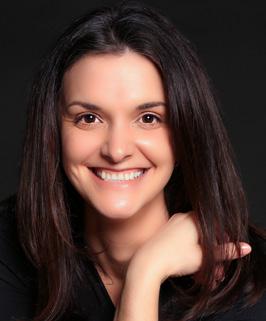
It was a moment no leader is ever truly prepared for. One of our high school students collapsed during a basketball game and died later that night. Her family was present. Her peers witnessed the scene. And our staff—teachers, coaches, board members—were suddenly thrust into the kind of collective trauma we hope we never face.
And yet, what surprised me most wasn’t the tragedy itself. It was how instinctively our team responded. It wasn’t a script. It wasn’t a formal plan. It was presence, compassion, and relational leadership in motion.
In the weeks and months that followed, I reflected deeply on what shaped that instinct. Where had I learned to lead with such care, caution, and awareness in a moment where there was no guidebook? The answer was simple: my mistakes.
Some were professional—things I had done wrong in lower-stakes moments. But many were personal. I’ve lived through a lot of school-based loss. As a student.
As a peer. As the child of a teacher in a small rural district. And those formative experiences informed not only my actions, but also the boundaries I put in place to protect our students, our staff, and our grieving community.
This article isn’t about a single moment. It’s about the lessons I carried into that moment—and the ones I’ve learned since.
When we lost our student, our district had a crisis plan. It was strong—so strong, in fact, that our Regional Office of Education now uses it as a model. But a plan on paper is a very different thing from living through a crisis in real time.
What carried us through wasn’t just the plan. It was the lens of emotional intelligence:
• Self-awareness kept me from rushing decisions out of my own fear and urgency.
• Empathy allowed me to anticipate the needs of grieving staff and students before they had words for them.
• Relationship management helped me navigate the tension between public grief and private pain.
In those first days, we made choices grounded in people, not just optics: restructuring a SIP day to focus on grief
and trauma, creating safe spaces for tributes away from the students’ locker, and drawing on trusted mental health providers for support. Each step was guided by transparency and compassion.
By Friday night—less than 24 hours after her passing—a memorial had already begun to appear outside our Junior High. Students gathered there, hugging, crying, leaving flowers, teddy bears, and handwritten notes. It was natural and deeply human. In moments of collective grief, people need something to do, and pop-up memorials are one of the most organic expressions of that need.
But from my home that night, I saw the safety risks right away. The memorial sat alongside a busy road with no barrier between traffic and the crowd. It was also directly at the Junior High entrance—a space that served our fifth through eighth graders, many of whom were still developmentally unable to process such visible grief.
By Saturday morning, I was out in a cold January rain, gently moving the tributes. We relocated them to the High School lawn—a safer, symbolic space marked by a flagpole and raised base. Before moving anything, I called the student’s mother, explained the concerns, and
promised every item would be preserved. She was gracious and supportive.
National Center for School Crisis and Bereavement:
• Temporary memorials are appropriate when they arise organically, but they should be time-limited.
That was the moment I learned this truth: the first act of mourning sets the tone for everything that follows.
I followed up with a message to families and students: clear, compassionate, transparent. Everyone needed to know this was done with care and with the family’s blessing. When students returned to see their items had been moved, they didn’t feel erased—they felt respected.
Still, one question gnawed at me: how long should this stay? A week? A month? Until the end of the school year? And practically, this was January in the Midwest. Balloons deflate, flowers rot, teddy bears get soaked. At what point does a tribute meant to comfort actually harm those walking past it every day?
Until that moment, I had been leading by instinct. But this decision had no obvious answer. So I turned to the mental health professionals who had surrounded us that weekend. Their advice was clear: two weeks—one week after the funeral.
That guidance aligned with what I would later read from the NASP and the
• Long-term displays can stall healing or unintentionally communicate that one life is valued more than others.
• Visually intense shrines in common spaces can overwhelm students and impair their ability to return to normalcy.
So we followed their lead. I communicated a removal date, explaining that every item would be preserved and delivered to the family. When the day came, we gathered each note, flower, and ribbon quietly and respectfully. Nothing was discarded. Nothing was treated as debris.
Looking back, if I could do one thing differently, it would be this: I would have anticipated the memorial’s formation from the very start. Pop-up tributes are so common, so expected, that leaders should be ready before the first flower is ever placed.
That was the moment I learned this truth:
the first act of mourning sets the tone for everything that follows.
In the immediate aftermath, memorials were raw and necessary. They gave students and staff a place to channel their sorrow, to feel connected, and to begin the impossible work of making sense of what had happened.
But as the weeks passed, the tributes didn’t slow. They multiplied.
Her birthday in May brought requests for a balloon release on our newly installed turf field—a request complicated not only by facilities and cost, but also by pending state legislation against helium releases. We offered alternatives. The family declined. The tribute moved to the cemetery.
That moment marked a subtle shift. The center of gravity moved from school to family. In some ways, that was natural. Four months had passed. Students were finishing the school year. The sharpest edges of grief had softened, and many were ready for remembrance rather than active mourning.
But it wasn’t that simple.
Because this student had been so involved in sports, in clubs, in friendships—there was always another group who hadn’t yet grieved publicly,
who hadn’t had their moment. Each new tribute carried love, but also unintended consequences: students who felt suffocated by reminders, families who compared tributes against their own past losses, and staff unsure how or when to move forward.
The longer it went on, the more memorialization became a dividing line instead of a unifying force.
This tension wasn’t new to me. I’d seen it before.
In high school, I was on the yearbook staff during an unusually tragic year. Four students in our school died, each in separate incidents. By the time we submitted our cover design in March— red bricks with the theme “Another Brick in the Wall”—three students had passed. We added their initials on the back cover, carved into the design as a subtle but powerful tribute.
And then, in May, a fourth student died by suicide.
It was too late to change the cover. Inside the book, we honored all four equally. We explained. We apologized. But the absence of that last student’s initials on the cover lingered. Some believed it was intentional. Others believed it reflected judgment about the manner of his death.
In trying to honor the dead, we hurt the living. Our inconsistency left wounds.
That experience stayed with me. Years later, as a school administrator, I understood why: grief needs consistency, and perceptions matter more than intentions. And we must always be ready for the unthinkable to happen again.
What I learned in those months—first as a teenager, later as a leader—was this: grief must be honored, but it must also be guided. Without boundaries, one loss risks overshadowing others. Without
remembrance and family-led efforts.
• The courage to redirect tributes in ways that balanced compassion with developmental appropriateness for students.
There is no way to lead perfectly through grief. But if I could offer one lesson, it would be this: anticipate the memorials. Don’t wait for them to appear. Gently guide them toward safe, visible, timebound spaces.
Protect emotional space—remember that not all students grieve publicly. Plan
Without consistency, one family feels honored while another feels forgotten.
consistency, one family feels honored while another feels forgotten.
Schools sit at the crossroads of public and private grief. That means leaders must make hard calls—sometimes saying no to what feels emotionally urgent in order to protect the longer arc of healing.
We found ourselves needing policies we didn’t yet have:
• Clear memorial guidelines rooted in equity and trauma-informed practice.
• Boundaries between school
ahead, even if you never need the plan. Name the tensions instead of pretending they don’t exist. And above all, lead with heart as much as with protocol. In the middle of the emotional tumult of a crisis is not the time to try to think clearly about unintended messages and longterm sustainability.
I didn’t get everything right. But what we did well—what allowed our district to carry this loss with dignity—was rooted in presence, humility, and care.
And if the worst day comes for another
leader, I hope these reflections help light their way, even just a little.
Dr. Lynette Thrasher is the Assistant Superintendent at Momence CUSD #1, where she leads curriculum and student
services with a focus on relationships and well-being. A founding member of her region’s Crisis Assistance and School Support Team, she is currently working on a forthcoming book on grief leadership in schools.
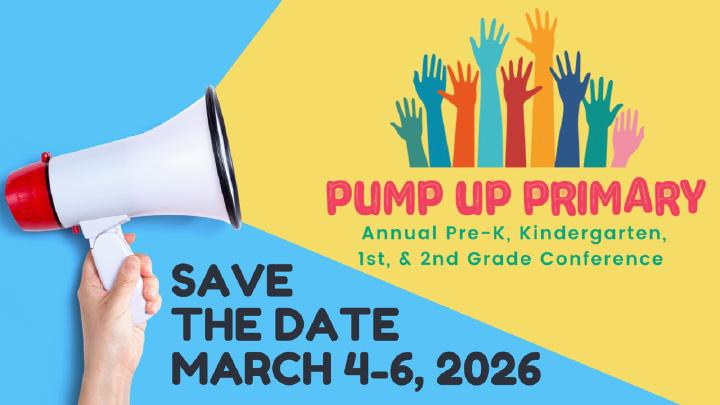
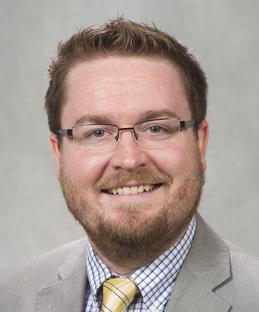
Dakota Horn

Incorporating instructional design best practices has so many intricate layers to consider. Instructors can find best practices on how to structure content, build a rubric, create an assignment description... and the list goes on. It is a constant conversation that evolves. Every educator can point to certain expectations, standards, practices supported by research, and tricks they learned through their many years of teaching. But what happens when all of those things actually cause concern for your students? And they call you out on this?
One of the authors is a student who voiced concerns over course design principles. The other author was their instructor. Their conversations open the door to a reflection on what can be done to improve our instructional efforts and to the challenge that these efforts need to be prioritized. We explore how instructional materials using best practices “box in” a student. We discuss that the focus of the course content is limited, and the student is looking for more. Finally, we walk through how “good” assessment design limited the student. This is not an exploration of what is right or wrong, but how these conversations helped improve courses. This is an encouragement to be reflective and
Instructional Design (cont.)
include students in the conversation strategically. And it’s ok to admit that you need to change something.
Best practice at issue:
Using standardized course materials and uniform content delivery to ensure consistency across classes (Phillips & Garcia, 2015)
Instructor:
I’ve always tried to choose standardized course materials and a single textbook for specific subjects so every student receives the same information and structure, ensuring fairness and consistency across all sections, classes, and different groups. It is assumed this approach helps reduce confusion, provides a clear roadmap for success, and helps students meet learning outcomes more efficiently. When a student comes to you and says that the materials themselves were causing concern, it gave me quite a shock.
I understood these structures were meant to help us meet learning outcomes, but for me, they limited creative expression.
Student:
One of my biggest challenges in the course was how the content was presented through the textbook and assignment materials. While intended to guide students toward success, I often felt “boxed in” by the standardized formats and rigid examples. Specifically, in my speech class, the outline structures promoted in the textbook felt formulaic, almost as if deviating from them meant my work would be considered “incorrect.” I understood these structures were meant to help us meet learning outcomes, but for me, they limited creative expression. So, I went to the instructor and brought up my concerns.
Conversation Result:
After our conversations, we reconsidered how content could be framed to keep essential learning goals intact while providing more flexibility. For example, instead
of requiring one standard outline format, multiple models could be presented, allowing students to choose the structure that best fits their communication style. Similarly, assignment instructions could focus more on the “why” and “purpose” of the task, rather than over-emphasizing one “correct” way to execute it.
Content
Best practice at issue:
Focusing content to cover fewer areas with more depth and rigor (Hess, 2023)
Instructor:
In this speech class, we cover speech anxiety and apprehension. The focus is to cover particular techniques, such as systematic desensitization and breathing exercises in depth, and not cover other ideas because of the concern of too much breadth instead of covering the depth needed. I emphasized repeated practice and exposure because research shows it helps reduce performance anxiety and builds skill over time. I believed this method would give students confidence and a sense of mastery, making them more comfortable in communication settings. Again, the student came to me with concerns over the lack of broad applications. This was the issue that was hardest to hear about. I believed the material provided had a universal approach.
It ... sometimes created pressure to “fix” ourselves in ways that felt unrealistic.
Student:
The course briefly covered communication apprehension and anxiety, but often framed these as challenges that could be overcome simply by practicing more. For students with deeper or ongoing challenges, whether anxiety-related, neurological, or otherwise, this seemed to oversimplify the reality. It also sometimes created pressure to “fix” ourselves in ways that felt unrealistic. I just wanted more information, broader perspectives, and other things to consider.
Conversation Result:
In response, we worked to design instructional materials that more explicitly acknowledged different learner needs. This included adding brief resource sections
in modules linking to campus support services, integrating optional practice activities for different comfort levels, and presenting multiple pathways to demonstrate learning. These strategies didn’t lower the expectations but provided flexibility for students to meet them in ways that worked for their abilities and circumstances.
Assessment
Best practice at issue:
Using detailed rubrics and highly prescriptive assignment descriptions to make grading transparent and consistent (Frontier, 2021)
Instructor:
I created detailed rubrics and highly specific assignment descriptions to make grading transparent and objective. Having a clear and specific rubric to help students meet standards seems like what needs to be done. I believed that outlining every expectation would remove ambiguity, help students self-assess their work, and make the grading process feel fair and predictable.
Student:
Rubrics, while intended to provide clarity, often increased my anxiety and reluctance to use my voice when writing or speaking for an assignment. Knowing that my grade hinged on meeting exact criteria sometimes made me more focused on “checking boxes” than on actually communicating well. Assignment descriptions could also feel overly prescriptive, which limited experimentation. I understood their purpose, but wanted to talk about how I could work around them.
Following our discussions, we experimented with rubrics that emphasized broader performance categories rather than narrowly defined checklists...
Conversation result:
Following our discussions, we experimented with rubrics that emphasized broader performance categories rather than narrowly defined checklists, giving students more room to demonstrate mastery in their own way. They also added reflective prompts where students could explain their design choices, which allowed the assessment to capture both the final product and the thinking behind it.
Instructional design should be flexible enough to evolve with student feedback, maintaining academic rigor while also making space for varied ways of learning and demonstrating knowledge.
The most valuable part of this process was the conversation itself. The student shared how certain “best practices” of instructional design unintentionally created stress or limited their engagement. The instructor was willing to re-examine those practices and not to discard them entirely, but to adapt them so they worked better for different learners. This is difficult when it challenges things you thought were the best idea for learning. These ongoing discussions have shaped course materials, assignment formats, and assessment strategies. The takeaway: instructional design should be flexible enough to evolve with student feedback, maintaining academic rigor while also making space for varied ways of learning and demonstrating knowledge.
The prompt for this forum was to reflect on learning experiences that might have been difficult. Having a student come to you and tell you that the best practices you’ve followed are causing them concern is not a fun conversation. Those conversations happened because
of a strong student and a chance to give that feedback. As an educator, be vulnerable to have those conversations. Build in opportunities for students to provide that feedback, and be willing to listen to these difficult conversations and change on the fly. It is crucial to realize that it is okay to have students challenge and question set expectations as long as these challenges are presented in a respectful manner, and can help improve the learning environment. As educators, be open to reviewing how what we thought was best for our students might actually be getting in the way, and how we can strategically build in ways to get that feedback. From this student and educator to everyone out there, it wasn't easy, but changed the educational experience for the better.
References
Frontier, T. (2021). Teaching with clarity: How to prioritize and do less so students understand more. ASCD.
Design (cont.)
Hess, K. (2023). Rigor by design, not chance: Deeper thinking through actionable instruction and assessment. ASCD.
Phillips, G. & Garcia, A. (2015). Setting Performance Standards for Success. A. American Institutes for Research.
Dr. Dakota C. Horn is Associate Dean for Academic Programs and Associate Professor in the Department of Communication at Bradley University, serving as the Oral Communication Course Director. His research interests and contributions span areas such as communication pedagogy, instructional communication, instructional clarity, humor, storytelling, accessibility in online education, general education initiatives, K–12 education, communication anxiety,
teaching activities, civic engagement, and fostering teacher-student relationships that enhance clarity and reduce anxiety.
Dr. Horn served on the Board of Education, presented research at the Illinois State Board of Education conference, and at the National Rural Educators Association.
Dr. Horn oversees Bradley’s corporate Instructional Design Certificate, a 15-week non-credit program.
Joanna Franco is a lover of learning, who has used that passion to become a firstgeneration college graduate and current law student. She earned her bachelor’s degree at Bradley University, with majors in Political Science and Philosophy, and minors in Business Law and Ethics. As part of her journey and goal of becoming an elected official, she is continuing her education at Marquette University Law School.
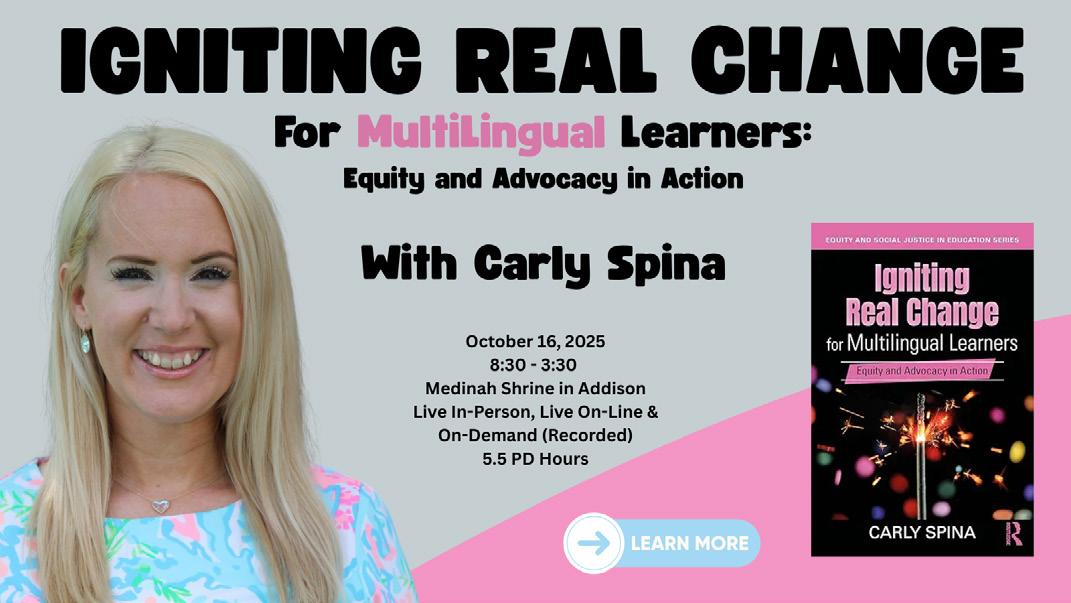
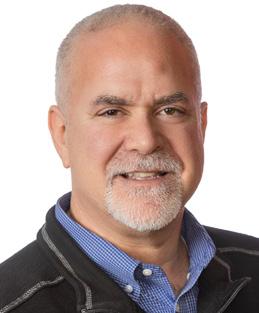
Michael Lubelfeld
Vision is one of our most precious senses. For most of my life, I took my eyesight for granted. Then, about a decade ago, my personal vision began to blur. The experience of my eyesight deteriorating became a powerful metaphor for the importance of organizational vision. Just as I had to make a conscious choice to address my failing sight, leaders must actively work to clarify and maintain their organizations' vision.
My journey began with a slow but steady decline in the vision of my left eye. For 35 years, eyeglasses had been my simple solution. They were a reliable method of correction. But suddenly, they weren't enough. I learned I had cataracts in both eyes. Interestingly, my brain had compensated, allowing my right eye to work harder to make up for my left. It fooled me into believing I could still see clearly.
This experience got me thinking. Have you ever been in a leadership position where you felt a shared vision existed, but in reality, your team was compensating for a lack of clarity? A cataract on the eye is like a blurry, unshared vision in an organization. It impedes progress and distorts reality. The old ways of doing things—like my reliable
eyeglasses—were no longer sufficient. To see clearly again, I needed to unlearn old habits, embrace change, and grow.
Cataract surgery required the removal and replacement of the lens in each eye—a much more invasive process than simply updating my glasses. As someone squeamish about medical procedures, this was a difficult choice. I had to confront my fears, accept the risk and uncertainty, and let go of a 35-year habit of wearing glasses.
After two successful surgeries, the change was nothing short of miraculous. My brilliant ophthalmologist inserted a distance lens in my right eye and a reading/mid-range lens in my left. The result? I had better vision than ever before—no more glasses, no more limited night vision. The new "normal" was far superior to the old one. This personal transformation was a powerful lesson in embracing significant change for a dramatically better outcome.
Like personal change, organizational change is often a response to something that happens, and it requires us to adjust, grow, and unlearn. Our vision, both personal and professional, often needs to be corrected so that new methods and improvements can be embraced.
In North Shore School District 112, where I've served as superintendent since 2018, we recently embarked on a strategic planning process. This wasn't about small tweaks; it was about defining our future. Strategic planning is a complex, multi-faceted process of input, reflection, and shared aspiration. It's about collaboratively creating a new mission, vision, and values.
Our new vision, established in March 2025, is this:
"Our vision is to be a thriving, inclusive, learning community where each student is empowered to reach their full potential and achieve their greatest aspirations. By utilizing evidence-based practices, innovations in teaching and learning, and personalized support, we create an environment where each student learns, grows, and achieves academic excellence. We nurture resilience and foster meaningful relationships, while developing transformative leaders, engaged learners, and responsible citizens who are inspired and equipped to make a positive impact."
An organizational vision is an aspiration, a hope for the future. But a shared vision is what makes it powerful. It's when every member of the organization synthesizes
their individual hopes and aspirations into a common cause. My role as a leader is to inspire that shared vision, to turn multiple points of input into a coherent action plan, and to create meaningful change that everyone is invested in.
where technology would reduce a threeperson job to a single person and a robotic arm?
This technological shift didn't necessarily eliminate two jobs; it transformed
My role as a leader is to inspire that shared vision, to turn multiple points of input into a coherent action plan, and to create meaningful change that everyone is invested in.
The importance of a clear vision extends beyond our own organizations. We must also have a clear vision for the future our students will enter. I was reminded of this recently while walking my dog and watching a waste management truck. The truck pulled up to the recycling bin, but the driver didn't get out. A robotic arm extended, grabbed the bin, emptied its contents, and placed it back on the curb.
I couldn't help but think about my childhood. When I was a boy in the 1970s, a garbage truck had a crew of three people: a driver and two workers who rode on the back. This simple observation sparked a big question: Did my elementary school teachers, four decades ago, contemplate a future
them. It created new jobs in robotics engineering, engine design, and technology maintenance—roles that required skills and knowledge unimaginable in the 1970s. The waste management industry’s vision to increase efficiency and integrate technology changed the nature of the labor force.
As educational leaders, this is our challenge. We must support and lead organizations that are preparing students for jobs that may not even exist yet. The waste management story is a reminder that we must consistently refine our vision to meet the demands of a rapidly changing world. My personal vision is clear, thanks to medical intervention. My organization’s vision is clear, thanks to a strategic planning process.
My question for you is: can you see clearly in your personal and professional life? What will you do to correct your vision?
Subject content was taken from blog posts I previously published at https:// mikelubelfeld.edublogs.org on January 22, 2017 and April 5, 2016.
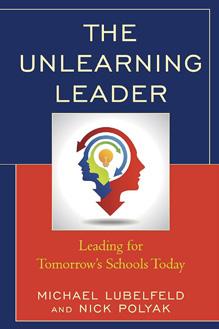
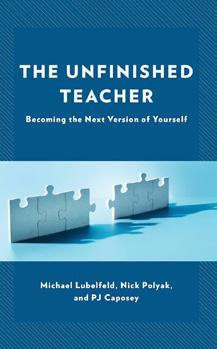
Dr. Michael Lubelfeld is superintendent of North Shore School District 112 in Illinois and has led school districts since 2010. A nationally recognized education leader, author, and speaker, he presents on leadership, student voice, global service, and innovation. He co-authored five books, including The Unlearning Leader and The Unfinished Teacher. Dr. Lubelfeld was honored as a 2025 Top 100 Influencer in Education and is a 2025-26 ISTE-ASCD Generation AI Fellow and Google-GSV Fellow. He has received multiple leadership awards and remains dedicated to empowering future-focused educators.
Click the covers to view on Amazon.
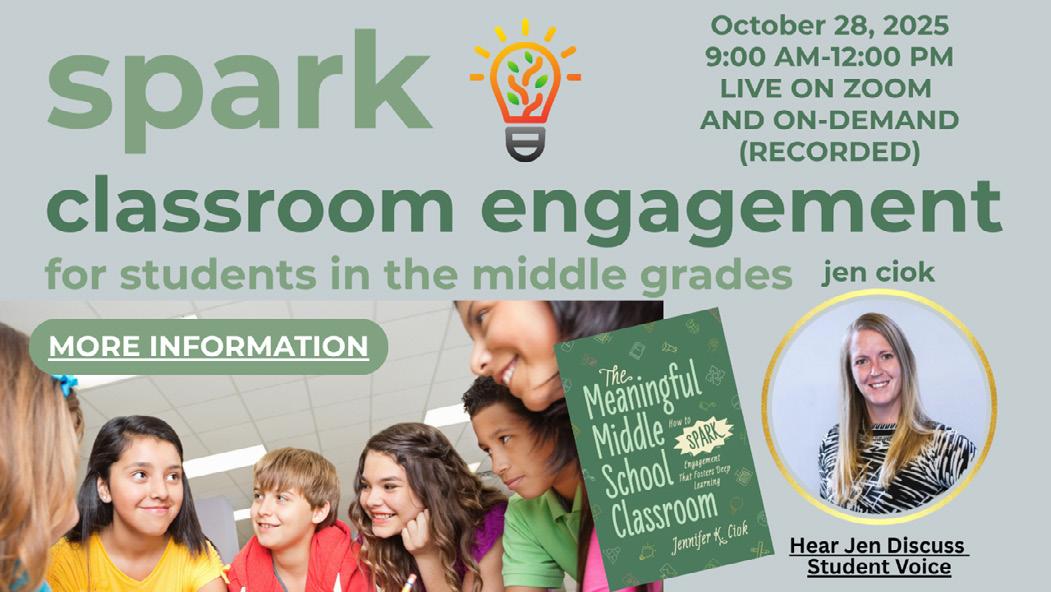
Our “Area Reps” are a link to and from the various regions of our state. IL ASCD follows the same areas established by the Regional Offices of Education.
Our Area Reps are led by a members of our IL ASCD Board of Directors, Denise Makowski.
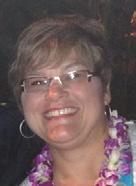
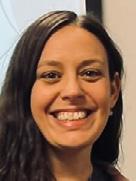
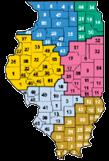
AREA 1: (Green)
Denise Makowski
Chicago
618.203.3993
dmkowski224@gmail.com
Amie Corso Reed
O'Fallon School District
618.203.3993
amie.corso@gmail.com
AREA 2: (Dark Blue)
AREA 3: (Yellow)
AREA 4: (Pink)
AREA 5: (Light Blue)
AREA 6: (Gold)
April Jordan
Jennifer Winters
Stacy Stewart
Jen Pollack
Chad Dougherty
Heather Bowman
Jamie Bajer
Mica Ike
Vacant
Contact information for them can be found HERE.
The roles of the IL ASCD Area Representatives are:
• Encouraging IL ASCD membership to educators in their local areas;
• Assisting with professional development;
• Attend board meetings and the annual leadership retreat, when possible;
• Disseminating information from IL ASCD board meetings or other sanctioned IL ASCD activities to local school districts or other regional members
• Being a two-way communication vehicle between the local IL ASCD members regarding IL ASCD or any educational issues.
• Keeping IL ASCD Board of Directors apprised of pertinent information regarding personnel issues (e.g., job vacancies, job promotions) and district program awards/recognition within the local area.
• Communicating regularly with IL ASCD Executive Director and the Co-Leaders of the Membership and Partnerships Focus Area.
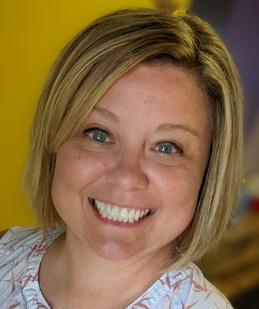
Melissa Gill
"One fundamental misconception is that SoR advocates simply want more phonics instruction. Rather, the advocates who know what they’re talking about want more effective phonics instruction” (Wexler, 2025).
During my primary teaching experience, explicit phonics instruction fell to the wayside as favor for 3-cueing practices gained the main attention in literacy (i.e. look at the picture). Following that current trend, book rooms were added to many schools based on an alphabetical book leveling system. I was expected to utilize those small group, predictable texts based on the results of a benchmarking system that grouped students by level.
In addition, grade level high frequency word lists were developed to time students on their ability to ‘read’ these words based on speed. Students were encouraged to memorize the words with their families—flashcards were sent home by the droves and goals were established by breaking the lists up into expectations for each quarter (none of those decisions were based on student data).
If students were struggling to read, the parents were called and pushed to read more books at home. Intensive small groups focused on reading short books and cutting
sentences apart. They were pasted in a separate journal and students were expected to add a picture. I honestly thought I was doing the best thing for my students by embracing these ideas including the famous Beanie Baby Reading Buddies (who didn’t love Chunky Monkey)! A decade later, my eyes have been opened to the impact of providing explicit and systematic instruction and the huge benefits for all learners in the classroom.
Several of us can probably recall a time we would love a professional do over. Mine would include the unsystematic approach to teaching phonemic awareness. Sure, we were singing songs and sounding out words as needed, but there wasn’t a direct approach of listening to the sounds and tapping out words. I rarely recall modeling how to listen for individual sounds and instead pushed the usage of a Word Wall for quick retrieval of whole words instead of focusing on an activity such as Tap It, Graph It, and Zap It.
The impact of Phonemic Awareness can’t be emphasized enough. Students who can take apart words into sounds, recognize their identity, and put them together again have the foundation skill for using the alphabetic principle (Liberman, Shankweiler, & Liberman, 1989).
There are so many available evidence based suggestions on how to meet the needs, but in my University Literacy Methods course we focus on two: blending and segmenting. It is with great joy that I now assist pre-service educators with the opportunity to learn how to model isolating sounds for their practicum students. Many of them reflect on the fact that they didn’t participate in such activities when learning to read. In the classrooms, I work consistently with current educators and instructional assistants on the proper pronunciation of sounds. It is quite common to hear a schwa added to the endings of sounds, which ultimately confuses our students.
How I remember the haphazard scope and sequence based on the book level! Phonics instruction did not include an explicit, clear cut pathway to achieve mastery. We were encouraged to use word families and pull skills from the predictable texts. Rosenshine (1987) described explicit instruction as “a systematic method of teaching with emphasis and proceeding in small steps, checking for understanding, and achieving active and successful participation by all students.” Looking back, I didn’t know what I didn’t know, and so I want to make sure others aren’t left to wonder best practices.
Currently, everyone is searching for the perfect curriculum resource—the best answer. After completing LETRS and Keys to Literacy training, my eyes were opened to five steps that should absolutely be included in all phonics lessons. In 30 minutes a day, we have the opportunity to set students up for lifetime success:
1. Review previously learned concepts.
2. Explicitly introduce & teach new concepts.
3. Guided Practice of new concepts by decoding and encoding words.
4. Utilize decodable texts to support new learning.
5. Apply knowledge of concepts utilizing sentence dictation.
There is so much controversary and hot conversation around decodable and predictable texts. Mostly what I can recall from my primary days is rewarding students for moving a level, for ‘reading’ a book—where they weren’t looking at words—and continuing on with the next level. Unlike today, I didn’t listen to students as they struggled to sound out words—most of the words were memorized (or they looked at a picture)! Nothing like the productive struggle encountered today as students decode words and learn how to sound them out for later success.
For sure, when students are in the first stages of decoding, we use decodable text to help them apply and master the skills we are teaching. I didn’t completely make sense of all the confusion until attending and learning from Dr. Wiley Blevins. During his session he clearly explained the purpose of utilizing decodable readers, "It's the application where learning sticks.”
In all of our work, it is important to note, explicit phonics instruction can be the gold standard —students excelling by leaps and bounds—but if we do not draw attention to fluency, comprehension will
Students have high levels of accuracy but they read word by word..
suffer. I’ve seen it happen in so many districts! Students have high levels of accuracy but they read word by word, lacking automaticity and stamina, and inevitably giving up on complex texts. Fluency is easily forgotten in the race
to reading complex texts. Dr. Jan Hasbrouck has been quoted as saying, “We should think about getting students to the point where their reading mirrors spoken language. That's what our brains understand. And that facilitates comprehension.”
Explicit and systematic phonics instruction is only a small piece of a bigger puzzle. But, it is an important piece of the puzzle that needs supported to move students forward in their literacy journey. How exciting it is to celebrate with a child when they have finally learned to truly read on their own—the moment is priceless! The work, although slightly painful and longsuffering at times, is truly rewarding.
References
Blevins, Wiley. Choosing and Using Decodable Texts. Scholastic, 2021.
Hasbrouck, Jan. What is Reading Fluency? NWEA Podcast, 2024.
Liberman, Isabelle Y.; Shankweiler, Donald; Liberman, Alvin M. The
Alphabetic Principle and Learning To Read. ERIC, 1989.
Rosenshine, Barak. Principles of instruction: Research based principles that all teachers should know. American Educator, 2012.
Wexler, Natalie. Beyond the Science of Reading. ASCD, 2025.
Melissa Gill is the Director of Teaching & Learning at Wabash Valley Education Center (WVEC), where she leverages her extensive background as a teacher, instructional coach, reading specialist, and administrator to support educator growth and improve student outcomes. With a passion for literacy and leadership, Melissa serves as a Literacy Instructor at Indiana University Kokomo and a Keys to Literacy Consultant. She is the Executive Board Secretary for the Indiana State Literacy Association. Melissa is dedicated to building strong partnerships and delivering impactful, evidence-based professional learning for Educators across Indiana.
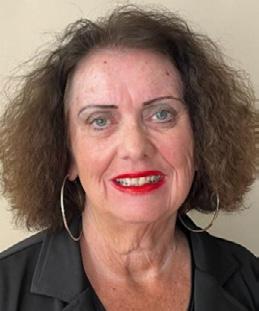
Heidi Schmidt Educators have the amazing job of guiding student learning; however, they are faced with challenges as the landscape for teaching and student services continues to change. Teacher shortages, student learning loss, and student behavioral or mental health concerns are among those challenges. In this article, ten teacher strategies are identified in an acrostic format with administrative supports needed for educators to thrive in their classrooms and personal lives.
Administrators and teachers have changed their instructional delivery and implemented innovative teaching plans to facilitate student learning. School districts have used a variety of strategies to equip teachers with different curricula, resources, and tools to guide their instruction to meet student needs. Various forms of professional development have also been provided for teachers. Twelve teachers and administrators in the Midwest and South contributed to the strategies in this article to assist teachers in being successful in the classroom.
With the challenges over the last few years, teachers and leaders are faced with pressures that include
increased student learning concerns and behavioral issues, staff shortages, and teacher mental health concerns, along with technology fatigue (Prendergast & French, 2022; Ascione, 2022; Ferlazzo, 2021). The most prevalent challenges that teachers face include their own mental health care, along with a sense of being supported by their administration.
One size does not fit all as to the support needed by teachers. Teachers need the tools, time, trust, and relevant training. The most prevalent challenge that teachers face is their own mental health care. Administrative support can be provided to teachers by acknowledging their contributions, offering self-care services, and providing the gift of time or training to complete all required teaching or classroom tasks.
The author has created a top 10 list of administrative teacher supports as strategies for overcoming the challenges faced in education. The list was inspired by the heartfelt responses of those currently in the field making a difference in the lives of students. The 10 strategies needed by teachers to succeed are: selfcare, time, relationships with those in the district/building, advocate for resources, trust in the efficacy of teaching, empowerment with decision-making support, grit and resilience, inspiration
to/for others, extraordinary synergy, and students’ love for learning.
S Self Care
T Time
R Relationships With All Those in the District/Building
A Advocate for Resources
T Trust in the Efficacy of Teaching
E Empowerment With DecisionMaking Support
G Grit and Resilience
I Inspiration To/For Others
E Extraordinary Synergy
With a new school year on the horizon, the 10 strategies can enhance the heroic work that teachers do in the classroom. Administrators can continue to support teachers by acknowledging their need for self-care, appreciating their quality work/skill strengths, and providing professional development, resources, and time that are needed for increased student learning. These crucial elements are foundational, not only for increased student learning but also for boosting teacher self-efficacy and retaining passionate educators in the profession.
T Time
R Relationships With All Those in the District/ Building
Teacher self-care and mental health awareness are a reality. Leaders should acknowledge the struggles that teachers face and offer support for teacher self-care solutions, such as wellness programs, mental health resources, changes in the teaching schedule, or paid self-care days.
Leaders can give teachers the gift of time, whether through a simple email instead of a meeting or by offering differentiated professional development based on the teacher’s needs. Teachers should have choices on the type of professional development for their own growth and the platform for learning such as face to face sessions, online webinars, peer observations or book studies. Administrators could designate meeting free days and protect any preparation time that teachers need for their students and planning.
Those in the district or building should continue to build relationships with teaching teams or in teacher learning communities. Leaders should continue to value building relationships, listening, taking action on concerns and showing teachers genuine appreciation. That could be a handwritten note placed on the teacher’s desk, shout outs during meetings or just checking on a faculty member’s family while walking the halls.
A Advocate for Resources
T Trust in the Efficacy of Teaching
Administrators are the advocates and sources that teachers need to secure resources, including equipment, technology, professional development and other classroom supplies, including those digital resources or SharePoint hubs so that teachers can find sources they need to save time. It is important that teachers have what is needed for their classroom learning spaces to meet all students’ needs.
Leaders should allow teachers to do their work as professionals. Allow them to grow a classroom leader and avoid micro-managing. As a leader offer support and coaching to build trust with teachers. Administrators should support teachers’ decision making which builds a culture of trust the school or district.
Leaders can empower teachers’ decision making through communication and positive interactive experiences. Allowing teachers to use their skill sets to benefit students learning and share their skill sets with other teachers. Highlight their strengths in team leadership projects and be that mentor to increase their efficacy.
Leaders should guide teachers to using coping skills like grit and resilience during challenging classroom times. Modeling a growth mindset, taking risks, problem solving and incorporating stress management techniques would contribute to the success of teachers in the classroom
Administrators should encourage educations to collaborate and provide opportunities for team building as teachers inspire others or to be leaders. Situations should invite innovation, encourage wonder and allow risk taking. Mistakes are new opportunities to learn. Take the time to celebrate, even those small wins with teachers. Having a positive attitude and assuming positive intent help inspire those on your team.
Educators do extraordinary work daily and hourly. Their energy and synergy should be recognized which will add to the school’s culture and student learning. The traditional activities of themed lunches, morning treats, short after school gatherings or gift card distributions can acknowledge those extraordinary efforts. However, there are many other ways to honor the energy they bring to the classroom.
At the center of what teachers do, student are always are the forefront of each decision and learning activity. Whether it’s through team meetings classroom walk throughs or formal observations, administrators can provide teachers support and feedback on their teaching strategies impacts student learning. Be that coach, mentor and leader to work together as you acknowledge the positive connections in the classroom with a goal for love of learning for students and teachers.
Ascione, L. (2022). 3 Major Challenges
Teachers Are Juggling in the Pandemic. eschoolnews.com/2022/03/04/3major-challenges-teachers-arejugglig-in-the pandemic
Ferrazzo, L. (2021). Pandemic Lessons for a Post COVID-19 Classroom. edweek. org/teaching-learning/opinionpandemic-lessons-for-a-post-covidclassroom/2021/01
Prendergast, L. & French, A. (2022). How Administrators Can Help Prevent Teacher Burnout. https://www. edutopia.org/article/supportingteachers-difficult-year
Dr. Heidi Schmidt walked the path as a teacher, Associate Principal, Middle School Principal, and District Administrator. Her school district in Wisconsin was recognized in 2017 as a leader in school-based mental health awareness and interventions by the Department of Public Instruction. Dr. Schmidt has spent 15 years working in higher education as an adjunct, professor, and department chair. Dr. Schmidt has received several state and international awards for her poetry and has authored three books. She lives in northern Illinois with her husband, but spends the winter in Alabama. (Heidi would like to thank Nicole Frederick for her contributions.)
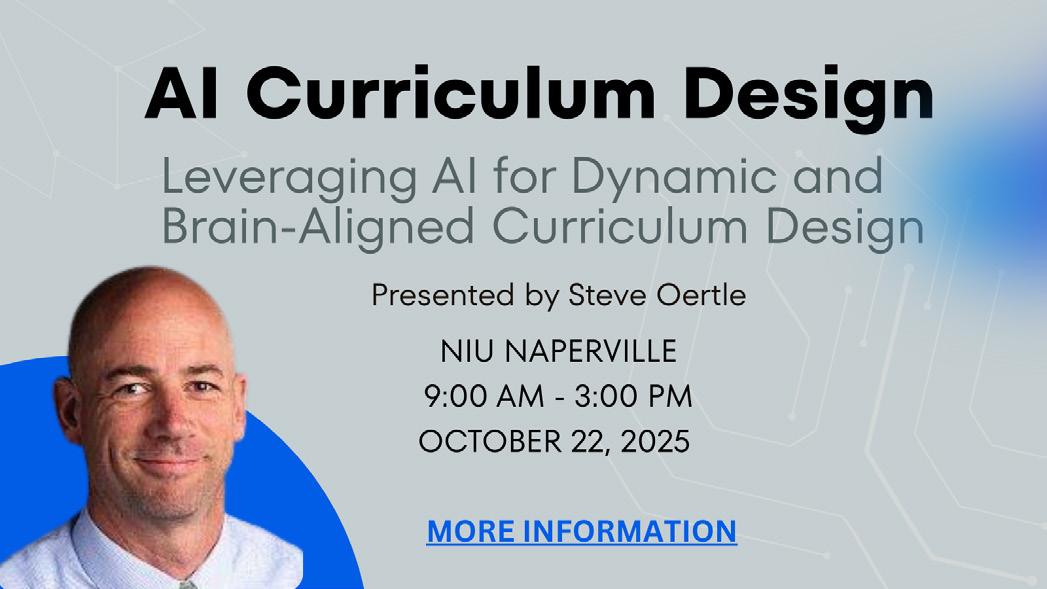
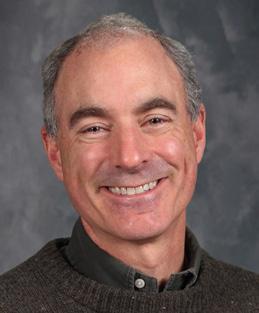
Erin Roche
The goal was noble, but the failure was colossal.
Like every school community in Illinois, we wanted our 8th graders to take Algebra so they could complete PreCalculus in high school. With this math background, our students would be much more likely to attend and graduate from college. Algebra would thus put them on the path to the lifelong stability, comfort, and fulfillment that corresponding high-paying jobs afford.
The failure was a lack of access to Algebra.
In 2019, my little Chicago neighborhood school was emblematic of the larger district’s access squeeze. At least half of the 8th graders in my K-8 school were missing out on this golden opportunity because we didn’t have an Algebra-certified teacher. But the true scope of the problem was much larger: Over 20,000 Chicago Public Schools 8th graders were being denied Algebra annually, meaning they were also being denied the many lifelong benefits of the Algebra pathway.
The cause of the access problem was the lack of Algebracertified teachers. The district prohibits the teaching of Algebra without such a certification, but only about half of the 350 or so K-8 elementary schools could boast such
a teacher. The result was that thousands of 8th graders were not learning Algebra. Pre-COVID, over 20,000 of our 8th graders were denied access annually. Over a five-year period, that means over 100,000 of our 8th graders were missing out on this life-changing opportunity!
In July 2020, like so many others, I was working feverishly to begin a school year in remote learning. Several incredible tech-savvy teachers had brought the
Another challenge I was facing was that my 8th graders couldn’t take Algebra in the upcoming year without an Algebracertified teacher. I needed another option.
As a community, we were dedicated to preparing all of our 8th graders to successfully take Algebra, including inclusion students with IEPs. Teachers had already done the hard work of adjusting the scope and sequence to cover 8th-grade math in 6th and 7th
...hire a dozen Algebra teachers whose exclusive job was to teach five sections of 8th graders Algebra online.
whole staff up to speed on Meets, Flipgrid, ScreenCastify, Seesaw, Google Classroom, and so much more. Now we were moving the entire curriculum online for full daily instruction for Kindergartners to 8th graders.
At the same time, I was working to set up an online high school math class for a rising 7th grader, Jeffery (name changed), who had already taken all the math our K-8 teachers could provide. I was emailing and calling high schools and the district’s tiny but helpful math department to determine the options. One was for Jeffery to take the class online with high schoolers.
grades. Our K-8 teachers and the school community were committed to doing the extra work to ensure that all students would be ready for Algebra for All. All we needed was an Algebra-certified teacher.
That’s when the light went on in my head! Eureka!
If the district could provide Jeffery with an online option, then surely it could create whole cohorts of 8th graders to take online Algebra from a certified teacher. Indeed, the district could hire a dozen Algebra teachers whose exclusive job was to teach five sections of 8th graders Algebra online.
12 teachers x 5 sections of Algebra x 25 students/section = 1,500 8th graders in Algebra
I immediately whipped up a proposal and sent it off to my contacts in the minuscule district math department. We had a frenzied phone call full of ideas, possibilities, and positive energy. With their insights and encouragement, I shaped the proposal below (edited for length and content) and sent it to Sherly Chavarria, then-Chief of Teaching and Learning.
Hello! I’m writing to ask for and offer help to elevate both Prescott’s and the district’s access and equity in 8th-grade Algebra to thousands across Chicago. I had a riveting, inspiring conversation with the Math Department on Monday about 8th-grade Algebra.
The problem of 8th-grade Algebra access
• Eligible, prepared 8th graders across the district are dependent on teachers to be willing to become 8th-grade certified in Algebra. At Prescott, we no longer have an 8th-grade Algebra-certified teacher. That isn’t fair to our students.
• Transporting 8th graders to high schools for Algebra is not logistically feasible, safe, or equitable. Most schools do not have the additional funds to support supervision during transportation, or
the wherewithal to get all the students there and back.
• The mostly wealthy North Side schools are overcoming these two problems through ad hoc solutions, which makes 8th-grade Algebra an access and equity issue for the district.
• Prepared students should all have access to quality Algebra, independent of transportation, funding, or certified teachers.
• Eligible 8th graders take Algebra via Remote Learning in high school hubs around the district during the pandemic and post-pandemic.
• A high school teacher teaches via Remote Learning, including pre-recorded videos, small group instruction, online Exit Tickets, and the Algebra Exit Exam (AEE).
• I’m offering Prescott as a champion or pilot to partner with a high school to increase access to Algebra for all eligible students. Please let me know how my team and I can help make this a reality for thousands of middle schoolers.
And Sherly made it happen! By the Fall of 2022-23, several hundred 8th graders
1,000 8th graders took Algebra in 8th grade from seven teachers dedicated to online-only teaching, a program referred to as Algebra Hubs.
The Algebra pass rate improved
More good news! The pass rate has improved each year and is now 56%, which matches the district average for 8th graders who take Algebra in-person from Algebra-cer tified teachers. As the number of 8th graders taking Algebra online increased, the pass rate also increased!
across the district had access to an Algebra-certified teacher through online classes. Just this past year, in 2024-25, over 1,000 8th graders took Algebra in 8th grade from seven teachers dedicated to online-only teaching, a program referred to as Algebra Hubs.
Online access to Algebra in K-8 schools without Algebra-cer tified teachers 8th graders in Algebra Hubs Schools with
Geometry. The 500 8th graders who didn’t pass the AEE are taking a second year of Algebra, which will deepen their math understanding.
Access to Algebra in 8th grade skyrocketed
access to an Algebra-cer tified teacher through online classes. Just this past year, in 2024-25, over 1,000 8th graders took Algebra in 8th grade from seven teachers dedicated to online-only teaching, a program referred to as Algebra Hubs
The Algebra pass rate improved
The Algebra pass rate improved
Source: CPS Math Depar tment
More good news! The pass rate has improved each year and is now 56%,
More to celebrate: The number of schools without access to Algebra in 8th grade plummeted from 47% in 2018-19 to 2% last year! Pre-COVID, roughly 183
More good news! The pass rate has improved each year and is now 56%, which matches the district average for 8th graders who take Algebra in-person from Algebra-cer tified teachers. As the number of 8th graders taking Algebra online increased, the pass rate also increased!
Last year, over 500 more 8th graders passed the AEE and are now taking Geometr y The 500 8th graders who didn’t pass the AEE are taking a second year of Algebra, which will deepen their math understanding.
Online access to Algebra in K-8 schools without Algebra-cer tified teachers
8th graders in Algebra Hubs Schools with online Algebra Hubs Passed AEE (%)
Access to Algebra in 8th grade skyrocketed
More to celebrate: The number of schools without access to Algebra in 8th grade plummeted from 47% in 2018-19 to 2% last year! Pre-COVID, roughly 183 schools offered Algebra to 8th graders, and now roughly 340 offer it! (Some 300 schools offer the class in-person, while 142 offer it via Algebra Hubs). The vast majority of increases in Algebra access for 8th graders took place on the West Side and South Side of Chicago. All Nor th Side schools have access. Districtwide, only seven of over 350 schools do not yet provide access to Algebra to 8th graders–four schools on the South Side and three schools on the West Side.
Source: CPS Math Depar tment
of elementary schools with access to
Last year, over 500 more 8th graders passed the AEE and are now taking Geometr y. The 500 8th graders who didn’t pass the AEE are taking a second year of Algebra, which will deepen their math understanding.
School-based Algebra in 8th grade Online Algebra Hubs No Algebra for 8th graders
Access to Algebra in 8th grade skyrocketed
Source: CPS Math Depar tment
More to celebrate: The number of schools without access to Algebra in 8th grade plummeted from 47% in 2018-19 to 2% last year! Pre-COVID, roughly 183 schools offered Algebra to 8th graders, and now roughly 340 offer it! (Some 300 schools offer the class in-person, while 142 offer it via Algebra Hubs). The vast majority of increases in Algebra access for 8th graders took place on the West Side and South Side of Chicago. All Nor th Side schools have access. Districtwide, only seven of over 350 schools do not yet provide access to Algebra to 8th graders–four schools on the South Side and three schools on the West Side.
Number of elementary schools with access to Algebra for 8th graders
The district has also increased student access to in-person Algebra in 8th grade along the way to advanced math courses, as Chalkbeat repor ter Becky Vevea documented almost two years ago. She noted that the district's effor ts to cer tify middle school math teachers in Algebra led to steady growth in the number of schools that can offer Algebra over a ten-year period, from 209 to 366. In 2013, only about 10% of 8th graders took the Algebra Exit Exam; in May 2023, almost 25% took it. According to the Illinois Repor t Card, the district’s pass rate of 8th graders in Algebra now equals the statewide average. That’s progress for the district. However, there is more progress to be made, as we are still
which matches the district average for 8th graders who take Algebra in-person from Algebra-certified teachers. As the number of 8th graders taking Algebra online increased, the pass rate also increased!
School-based Algebra in 8th grade Online Algebra Hubs No Algebra for 8th graders
Last year, over 500 more 8th graders passed the AEE and are now taking
schools offered Algebra to 8th graders, and now roughly 340 offer it! (Some 300 schools offer the class in-person, while 142 offer it via Algebra Hubs). The vast majority of increases in Algebra access for 8th graders took place on the West Side and South Side of Chicago. All North Side schools have access. Districtwide,
Source: CPS Math Depar tment The district has also increased student access to in-person Algebra in 8th grade along the way to
only seven of over 350 schools do not yet provide access to Algebra to 8th graders–four schools on the South Side and three schools on the West Side.
The district has also increased student access to in-person Algebra in 8th grade along the way to advanced math courses, as Chalkbeat reporter Becky Vevea documented almost two years ago. She noted that the district's efforts to certify middle school math teachers in Algebra led to steady growth in the number of schools that can offer Algebra over a ten-year period, from 209 to 366. In 2013, only about 10% of 8th graders took the Algebra Exit Exam; in May 2023, almost 25% took it. According to the Illinois Report Card, the district’s pass rate of 8th graders in Algebra now equals the statewide average. That’s progress for the district. However, there is more progress to be made, as we are still failing thousands of 8th graders annually.
Meanwhile, the Consortium on Chicago School Reform at the University of Chicago continues to verify the positive effects of enrolling in Algebra in 8th grade. Work by Dr. Marisa de la Torre and others correlates passing Algebra in 8th grade with both the completion of advanced math courses and with scoring higher on the ACT college readiness assessment (as well as its 9th and 10th grade counterparts, PLAN), although she
cautions that higher-performing students tend to benefit more.
The Illinois Report Card provides excellent district and school data regarding overall and disaggregated Algebra pass rates of 8th graders. Unfortunately, though, the data include all 8th graders, not just those who took the Algebra Exit Exam. Last year in CPS, 29.3% of 8th graders passed Algebra, an increase from 24% in 2018. Happily, the gender gap is almost negligible in Chicago, but achievement gaps linked to race, low-income, IEP, and English Learners are glaring and demand major resource investments.
• Provide access to Algebra for 8th graders in the remaining seven schools.
• At each school, increase the percentage of 8th graders who take Algebra, ideally to 100%.
• Track the racial, gender, low-income, IEP, and English Learner rates for various sets of data, including:
- The disaggregated AEE pass rate of only the portion of 8th graders taking Algebra. (The
Illinois Report Card’s report of the pass rate for all 8th graders, including those who didn’t take Algebra, does not track the gains of the cohort of Algebra-takers.)
- Algebra Exit Exam pass rates for students who took Algebra in-person or via Algebra Hubs at each school.
These data would provide school communities with helpful feedback about successes and areas for future improvement.
While significant work remains, thousands of 8th graders now have access to Algebra on their way to completing advanced math in high school, as well as a path to completing college, which is proven to lead to a wealthier and more stable life. Using available technology, investing in teachers and their educational technology capacity, and making it easy for K-8 elementary schools to implement in the field were keys to easily and significantly improving access to Algebra for 8th graders in Chicago.
Districts around Illinois, especially rural districts, can use this same model to provide access to Algebra for 8th graders from Freeport to Murphysboro. This proven solution could profoundly
improve our students’ well-being for a lifetime and pay remarkable dividends for an entire generation.
Erin Roche is the longtime principal of Prescott School in Chicago Public Schools and has led schools for almost two decades. He also serves on the Board of Trustees of the Illinois Mathematics and Science Academy and is a school administrator representative to the Illinois Balanced Accountability Metrics Committee. He completed his EdD at Vanderbilt University and is a National Board Certified Teacher. He can be reached at eroche@cps.edu.
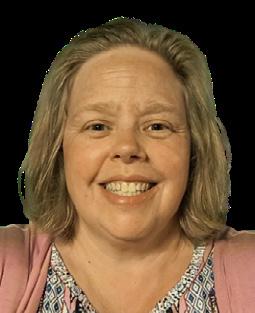
Amber Beutel
When people think about Executive Function (EF), they often picture self-control—waiting for a turn, keeping hands to yourself, resisting the urge to shout out an answer. But EF is much bigger than that. It’s the brain’s control center, made up of skills like working memory, flexible thinking, and self-regulation that allow children to plan, focus, remember instructions, and juggle multiple tasks.
In a kindergarten classroom, EF skills are developing rapidly, but they don’t just happen automatically. They need intentional, consistent practice woven into the school day. Over the years, I’ve built a classroom approach that nurtures EF through small, daily strategies that are playful, practical, and realistic for busy teachers. Here are five of my favorites.
Why it matters:
Flexibility is the EF skill that helps children adapt when things don’t go as planned. It’s what lets them switch from one task to another, adjust when the schedule changes, and see more than one way to solve a problem. Without flexibility, small changes can feel overwhelming,
leading to frustration or shutdowns.
How I teach it:
I model flexibility constantly—narrating my own adjustments in real time. If the art supplies I planned to use aren’t available, I might say, “Hmm, we don’t have markers today, so let’s think of another way to make our posters. Maybe we could use crayons or colored pencils instead.” My students hear me acknowledge a problem, consider options, and choose a new plan.
How to build it:
One of my favorite tools is “Switch It Up” routines—small, intentional changes to predictable tasks. We might line up from the back of the line instead of the front, read a book sitting under tables instead of in our reading nook, or swap partners
Why it matters:
Self-talk—the ability to talk yourself through a task—is a critical EF skill for problem-solving and self-control. It’s that inner voice that says, “First I get my paper, then I get my pencil,” or “I’m feeling upset, but I can take a breath.” Without it, children rely on constant adult prompting.
How I teach it:
I model my thinking out loud, especially during multi-step activities: “Okay, I’m going to get my scissors, cut out the shapes, and then glue them on.” I also encourage students to narrate their own process while working with a partner. This makes their thinking visible and strengthens the habit of verbal planning.
mid-activity. These tiny disruptions are safe ways to practice flexibility so children are better prepared for bigger, real-life changes.
Flexibility is the skill of bending without breaking—adjusting plans, trying new approaches, and learning that sometimes the best ideas come from unexpected changes, like switching partners mid-project.
How to build it:
Visual cue cards are a game-changer. I use simple picture sequences to guide routines—like “Get materials → Work → Clean up”—and refer to them while narrating. Over time, students begin using both the visuals and their own voices to guide themselves. These cues give independence while reinforcing EF skills in an age-appropriate way.
Self-talk is the voice that guides the journey — talking through steps, solving problems aloud, and reminding yourself that one small choice can lead to big success, like quietly narrating how to cut, glue, and assemble a tricky craft without needing to ask for help.
Why it matters:
Overload happens when working memory, attention, and emotional regulation are stretched to their limits. In young children, it can show up as restlessness, avoidance, or meltdowns. Reducing overload protects EF skills from burnout and helps students stay engaged.
How I teach it:
I keep transitions, expectations, and routines consistent. Predictability lowers the mental load, so children have more brain space for actual learning. When I introduce something new, I layer supports: first a visual, then verbal reminders, and finally gradual removal as independence grows.
How to build it:
Think of overload prevention as scaffolding. Break big tasks into smaller chunks, use clear visuals, and keep instructions short. During longer projects, build in “pause points” for a quick stretch or check-in before moving on. A calm,
structured environment gives EF skills the space they need to develop.
Managing overload gives the brain room to breathe—like a child who knows exactly what happens next in the morning routine, so they move smoothly from lining up to calendar time without frustration.
Why it matters:
When frustration or distraction takes over, EF skills like self-control and attention drop. Children need ways to reset so they can return to learning, ready to engage.
How I teach it:
In my classroom, we talk about two types of refocus:
• Calm reset: breathing exercises, sensory bottles, or sitting in a quiet space to regroup.
• Active reset: high-energy, quick movement breaks like “jump and count,” wiggle dances, or scavenger hunts around the room.
By giving both options, students learn to choose what works best for their bodies and emotions.
How to build it:
Create a “Reset Menu” that students can access when they feel stuck or frustrated.
Practice these strategies when children are calm, so they’re ready to use them during real challenges. Regular, intentional resets protect EF skills from stress overload and model lifelong coping tools.
Resetting refreshes mind and body— taking a breath, moving, or pausing for a moment so children can return calm and focused, like a student choosing a quick wiggle break before diving back into a challenging game.
Why it matters:
Play is where EF skills come alive. Planning play helps children practice decision-making, problem-solving, and reflection—cornerstones of EF growth.
How I teach it:
Each day before center time, my students tell me where they’re going to play and what they plan to do there. This small moment gives me the chance to encourage, coach, or help them troubleshoot past challenges. For example: “Yesterday your block tower fell early— what could you try differently today?”
How to build it:
Encourage reflection after play. Ask, “What worked well? What would you do differently?” These questions develop metacognition—the ability to think about
thinking—which strengthens EF across all areas of learning.
Play is where kids practice being the boss of their own ideas — planning, problemsolving, and sometimes figuring out how to share the one blue block everyone wants.
Executive Function isn’t an “extra” to fit in when there’s time—it’s the foundation for everything we do in the classroom. By embedding EF practice into daily routines, we give children the tools to adapt, plan, focus, and persevere—skills that matter far beyond kindergarten. Start small. Pick one strategy to try this week and make it part of your day. Your students’ brains (and future teachers) will thank you.
Amber Beutel has been an educator for 19 years and has spent the last 11 years teaching kindergarten. With a background in working with English Language Learners, she is passionate about helping young students build strong language and literacy foundations. Her work also emphasizes the development of executive functioning skills, supporting children in becoming confident, independent learners.

Every year, I choose a word to shape my thinking and planning. For the 2024-2025 school year, my word was "recursive." Webster defines recursive as "relating to, or constituting a procedure that can repeat itself indefinitely."
In preparing for the 2025-2026 school year, I reflected on where being recursive was helpful, asking where the procedures were that school leaders kept coming back to, that became ingrained in the fabric of our district, and what procedures are going to need to be iterated again for the coming year. Being intentional
Being intentional about going back to the procedure and reviewing the purpose of the procedure helped keep us focused on the changes we wanted to make...
about going back to the procedure and reviewing the purpose of the procedure helped keep us focused on the changes we wanted to make to math instruction in our district. The students in our district have far surpassed the conventional national wisdom of math scores. We have nearly doubled the percentage of students who are achieving at or above grade level since the pandemic. We attribute our success to continually coming back to how we are improving our instructional practices in math classes.
After COVID, the district started with a simple premise: in order to improve student academic performance, the quality of Tier 1 instruction would need to improve. School leadership teams began by tackling the quality of instruction by first improving the quality of planning. Reviewing unit plans for markers of quality and then giving feedback to teams started with a process of creating a common understanding of what planning for good math instruction could and should look like.
The district has been working on ensuring teachers are planning for strong math conversations among students. School leadership teams gave each other feedback on the quality of each grade’s unit planning for math instruction. The district leadership team began reviewing the feedback given to the teams about their planning to ensure it was focused. The math team took its first stab at recursivity by asking school teams to ensure prior feedback was reflected in the next unit’s plans. This was unwieldy and hard to monitor, measure, and support. But it made the teams begin to reflect on how to ensure their monthly review of plans actually had an impact on instruction.
Some teams had more success with this intentional practice than others. It took a lot of time and follow-through on behalf of the school leader and the school
leadership team. The math team worked directly with school leaders and school leadership teams to build their capacity in recognizing the hallmarks of strong planning for math. The teams that were the most successful were the ones that continued to ensure the incorporation of the previous month’s feedback.
Student academic performance, as measured by NWEA MAP, improved while the school and district leadership teams were monitoring and planning. But not enough to make anyone rest on their laurels.
The district team widened its focus to include feedback on instruction (Protheroe, 2009) and (Sinclair et al, 2020). Increasing the quality of our daily math instruction has become our single focus: creating more opportunities for students to participate in mathematical discourse around their thinking as the students solve math scenarios. All of our professional learning centered around teacher actions to facilitate these student conversations:
• the structuring of routines that ensure that all students get a chance to respond to every question
• crafting questions that drive thinking
• using student responses to connect inefficient problem-solving strategies
to the most efficient strategy in each context (Huinker, 2018).
While these three things were the focus of professional teacher learning in math, building administrators participated in professional learning around how to notice these actions and how to coach teachers in using these actions. Specifically, these actions were repeated and refined by teachers and admin over the course of two years.
Building leaders used a walkthrough protocol to help them identify those specific teacher actions. The district leadership team tracked the data on how often these teacher actions were seen during walkthroughs and reported gradual increases in implementation. That data was also used to drive additional professional learning for teams that seemed to be struggling with implementing strong math student discussions.
While the math department might be able to talk about the instructional practices used to create quality mathematical discourse in their sleep, referring back to the specific teacher practices in conversations with teachers, grade level teams, and building administrators in every conversation helped to make these practices part of the procedures teachers in our district use in teaching math.
As the district leadership team continued to monitor the data gathered during walkthroughs, it seemed that the implementation plateaued. Student achievement continued to grow, but the rate of growth had slowed a bit. The leadership team looked back at the things that had become procedures that were embedded in the fabric of a grade level’s work in planning and teaching math, looking to see where there might be procedures we could continue coming back to improve.
The team was well aware of the links between feedback and improvement. We wondered if that was our next point of iteration: how do we create feedback loops that became recursive: every time a walkthrough was completed in a class, the observer was giving feedback on the implementation of feedback from the previous walkthrough. This was a daunting task that required some technology lifts to make quickly reviewing the specific feedback easier. Once those were accomplished, it became clear that this was the next iteration: ensuring that feedback was given that targeted the specific teacher moves that constituted professional learning, the same teacher moves that were planned in the unit plans, and the same teacher moves that were the focus of the last round of feedback.
The schools that were able to strengthen the connection between planning for strong instruction and then supporting the implementation of that instruction saw impressive gains for their students.
Additionally, being transparent and clear about why teams are receiving the targeted, specific feedback and how the targeting is related to the learning teachers had been doing makes the
As the level of focus increased in the recursive process, the gains for student achievement were apparent.
As the level of focus increased in the recursive process, the gains for student achievement were apparent. The specific actions were not the magic; the recursive focus on the teacher's actions that promote strong math instruction was the key.
“When everything is a priority, nothing is a priority” (Martin, 2012). The district leadership team was able to create a procedure that supported the things that were important to strong math instruction: strong planning and quality instruction. The commitment to the procedure and a monthly cycle of reviewing, tweaking, and iterating the procedure created that recursive loop that ensured that all of the district’s actions were aligned: professional learning, district and school leadership practices, feedback given to teachers, and the implementation of professional learning and planning so often that it has become second nature.
recursive process clear for teachers and staff. Aligned, focused, targeted actions are a force multiplier, increasing the efficacy of the staff and the achievement of students.
My words of the 2025-2026 school year are "intentional and deliberate." These will remind me to continue to iterate and improve instruction, continuing to improve outcomes for students, and maintaining our focus on just the priority so that we can see real improvement in instructional outcomes for the students of our district.
Huinker, D. (2018). Principles to Actions: Moving to a framework for teaching mathematics. Teaching Children Mathematics, 25(3), 133-136.
Martin, K. (2012). The outstanding organization. Generate Business Results By Eliminating Chaos and Building the Foundation for Everyday Excellence, 2012.
Protheroe, N. (2009). Using classroom walkthroughs to improve instruction.
Sinclair, A. C., Gesel, S. A., LeJeune, L. M., & Lemons, C. J. (2020). A review of the evidence for real-time performance feedback to improve instructional practice. The Journal of Special Education, 54(2), 90-100.
Dr. Emmie Pawlak is the Director of Math, Science, and Accelerated Pathways in Cicero School District 99, which
shares a border with the great city of Chicago. While she may no longer be in the classroom every day, she is always a teacher in her heart of hearts. Her favorite professional work is around creating and supporting systems that elevate teachers' and leaders' instructional practices. This includes helping staff measure their impact quantitatively and qualitatively and then using those measurements to further student growth and achievement. Dr. Pawlak is also a language learner, growing daily in her acquisition of French and Spanish. Learning a second (or third) language has helped her support dual language learning environments as well. A core value of hers is that students should be not just biliterate but also "bi-numerate" and be able to use their whole linguistic repertoire to explain their math thinking!
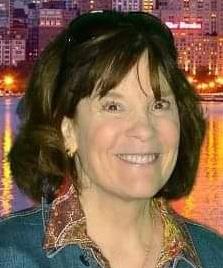
Amy Sussna Klein Introduction
A purposefully set up environment can act like another teacher in the classroom. When well-designed, it will help children in a multitude of ways, such as (1) providing direction, (2) helping them make conceptual connections, and (3) helping them analyze and think about their thinking (metacognition). An environment that supports learning like this does NOT just happen; instead, the educators need to take time to reflect, think carefully, and plan.
The classroom walls are an important part of the environment that often don’t receive the attention they deserve and are thus mishandled.
I was guilty of this myself early in my teaching career. Though I was always a conscientious teacher, my use of the walls was not ideal. With the best of intentions, I wasted time and money decorating the walls in ways that provided the children with little, if anything, of value. In this article, I will describe how I evolved through what I now call the four stages of classroom wall usage: (1) decoration, (2) mass production display, (3) individualized display, and (4) documentation.
I recall how excited and anxious I was when I began teaching. Every detail in my first-grade classroom was so important to me. When preparing the classroom, I wanted it to be ready with a happy, welcoming message for the children. At this time and place, to me, it meant putting up welcoming decorations. These decorations could be teacher-made or bought. Examples included: 1) apples, 2) leaves, 3) the alphabet, and 4) the lion and the lamb.
I found a stencil of an apple, then cut out apples for each child, writing their names on them, and put these on the wall. Then, I added signage with carefully cut-out stencil letters welcoming the children to my class. This may sound easy-peasy, but I am not a “cut and paste” type of person. It was time-consuming.
Another example was a welcoming tree decoration with many pretty leaves. I loved this one; to me, it signified fall. This involved me buying a commercial product at the teacher store. I did not have much money, and I wanted it to last for years, so next I laminated each piece and recut it. I then decorated a wall with these leaves surrounding a tree. Then, of course, I felt it needed the obligatory signage, so I got out my stencils and cut
out the letters to welcome the children to my class.
3) The Alphabet
There was also the alphabet strip, which the teachers felt was mandatory at the top of the blackboard. This was given to us by the school district. The alphabet was represented by some animal or object for each letter. (I still wonder about some of the choices. For instance, how many of these children in a small town outside of Kansas City had ever heard of a yak, for instance?
4) The Lion and the Lamb
I remember one year when I struggled for hours over drawing and cutting a lamb and a lion for March. I did the same timeconsuming stencil, cut, and laminate steps as above. I thought this was so clever: “In like a lion, out like a lamb.” In retrospect, I doubt the value of this, as this age group is a little young for idioms. More importantly, it had no relevance to them.
I was encouraged to incorporate this form of decoration into my classroom environment every month for my four years at the school by the principal, who favored this type of decoration and praised the other first-grade teacher for her outstanding arts & crafts skills and the considerable time she devoted to them. To stay competitive, I increased my efforts over the next four years, investing
more and more in fancier decorations of this type.
At the time, I felt a bit uncomfortable about how much time (and sometimes money) I spent on room decorations. In retrospect, I realized that my discomfort was due to the fact that I was spending time, energy, and money on these endeavors, but they were not doing much for my first graders.
... I was spending time, energy, and money on these endeavors, but they were not doing much for my first graders.
Most teachers are familiar with hand turkeys. You help the children trace their hands, they cut them out, and then they add a feather for each finger. The teacher typically adds feet. This craft project is generally done at Thanksgiving. Often, after the turkeys are posted, stenciled cut-out letters are added to complete it with a saying.
I started to wonder why the children were not interested in all the displays I had put on the walls. My conclusion was that it was because it was my work on the walls and not theirs. At around the same time, I moved cross-country and wound up in a different school where the director prioritized the children’s needs above all else. This gave me the opportunity to become more childfocused by making room on the walls for displaying the children’s own work.
I collected cute ideas for things they could make, such as 1) turkeys, 2) homes, and 3) snowmen.
Craft activities with snowmen and homes I will cover together, because the purpose for both was to focus on shapes. I (along with co-teachers) would stand up and demonstrate to the children how to glue the shapes in the desired way. Then, my team provided the children with the shapes (e.g., three circles for the snowmen and squares and triangles for the houses) and glue. We would walk around to assist, as needed, so that they could complete their prescribed project.
Over the course of each school year, my classroom walls would display the results of projects the children had done. “Aha!”
I thought, “They are getting a chance to express themselves,” and the parents loved the result.
At first, I thought I had solved the challenge of the walls, until I began to wonder about how much thinking the children got to do in the activities I set up. This became evident and problematic for me one day when a child asked which
and then you have another who paints carefully, filling up a page with a variety of details.
One challenge I faced was how to display this work. It certainly required more thought than putting 20 almost identical hand turkeys up on the wall, and I needed to consider what message was being communicated to the students by how
Let’s face it—with projects such as this, the child did it my way, or they did it the wrong way.
art project was his. The only way for it to have been different would have been for him to do it incorrectly. Let’s face it— with projects such as this, the child did it my way, or they did it the wrong way.
I realized that I was not providing them with an opportunity to challenge themselves to be creative or express their individuality.
Next, I moved on to displays where the students finally had a chance to create individual works, largely of their choosing. Let us be honest—when arts and crafts are done this way, you get a wide range of individual art each day. For example, you have the child who produces seven identical rainbows,
each of their art pieces was displayed. Individual works, such as these, deserve careful placement with a border around each piece, and you should never write anything on the piece itself, as that may be perceived as disrespectful
The teacher needs to reflect upon the message given when displaying work such as this. Teachers who are aware of the power of the environment reflect on what their words and actions communicate to the children, so they are thoughtful about these.
The more I focused on providing the children with the opportunity for individualized displays, the better I felt about the environment.
Eventually, I decided to pursue a doctoral degree in Early Childhood Education so I could have a deeper understanding of how a classroom could best be managed to further the children’s learning. It was during this
happened after the art project was done, but was rather the concluding stage of a larger arc of work involving both the children and the educators.
It began with the educators working together for many hours on how to
In a classroom of this type, the teacher is challenged to identify interesting projects and set things up to make these projects manageable, rather than spending hours creating dozens of cutout paper apples or similar tasks.
period that I learned about the Reggio Emilia schools and actually got to visit them. This was before the schools became well-known, so during my visit, I actually got to speak with Loris Malaguzzi, founder of the Reggio Emilia approach, and others there about what they were doing and how this helped the children.
It was here that I learned about their use of the walls for “documentation.” The breakthrough idea the Reggio Emilia educators had was not just about how to better use the walls for displaying the children’s work, but rather how they reconceptualized the whole process. To them, displaying the children's work on the wall was not something that
enrich what the child was creating and learning from their work. Then, as the children did their work, the educators would challenge them in a variety of ways, such as reflecting on how it worked with other media, making connections to their experience, and discussing their work. Finally, the children’s work was displayed, along with photos of them doing the work and quotes from them about what they had done. Thus, the “documentation” that visitors to these classrooms see is actually just the final part of a bigger process.
There was no question that the educational value of this far exceeded using the walls for commercial decorations and identical projects, and
even exceeded the value of unguided individual work. In a classroom of this type, the teacher is challenged to identify interesting projects and set things up to make these projects manageable, rather than spending hours creating dozens of cut-out paper apples or similar tasks.
Having learned from this experience, I graduated to using documentation myself. Eventually, I did my doctorate on documentation with the three authors of The Hundred Languages of Children, one of the most significant books about the Reggio Emilia schools. I am grateful to these incredible people.
My dissertation research examined the impact of using the documentation approach and required me to train teachers in several classrooms about documentation. Training teachers about documentation taught me more about it, myself.
It was during this stage that I realized that documentation could not be boiled down to a simple set of steps for a teacher to follow. Rather, it could better be thought of as a process that integrates into how the classroom itself is managed. Teachers trying to integrate this process into how they manage their classrooms are embarking on a journey. There is no endpoint to this journey. One just gets better at it over time. Thus, teachers should not think of documentation as a
set of steps they can check off, but rather as a rewarding journey at which they will continually improve.
Dr. Amy Sussna Klein’s career has spanned across preschool, elementary, 2-yr and 4-yr universities, and professional seminars with the largest portion teaching graduate and undergraduate courses in Early Childhood Education at the University of Missouri, Kansas City (UMKC). In addition to her higher education teaching, she also spent a dozen years as a National Faculty member for Pearson Education, collaborating with school districts and programs such as Head Start across the U.S. Currently, she operates an education consulting company.
Amy has written over fifty widely read articles, many of which are peer-reviewed; led a delegation to Budapest, Vienna, and Prague to study early childhood care practices; and has been deeply involved with the National Association for the Education of Young Children for many years. Besides speaking at national conferences, she also served as President for its chapter in Kansas City and as Treasurer for its Fox Valley, Illinois, chapter. The Kansas City chapter presented her with two of its highest awards for service. She continues to speak on the local, national, and regional levels.

Andy Accettola
For many years, my week began the same way: lugging a crate of readers’ notebooks from the backseat of my car to the corner of our 7th-grade ELA classroom, where they waited for Monday morning pick up. Students turned them in on Wednesdays, and despite my best intentions to respond to every entry by Friday, the crate often followed me home for the weekend.
Inspired by Nancie Atwell’s In the Middle, these notebooks became a private space for students to write weekly literary letters, a place to capture their thoughts, connections, questions, and emotional responses to their reading. Most Saturday mornings, I would sit at my kitchen table with a cup of coffee, a pen, and their words, finding the ritual both grounding and sustaining.
I wanted my students to see themselves as readers and thinkers, and I believed the readers’ notebook was the perfect conduit for this. Perhaps most importantly, I focused on what students did with the feedback I gave in return. I spent hours crafting comments I thought would make a difference, designing each one to harness what Hattie and Timperley (2007) describe as the powerful influence of feedback on student achievement. Back then, in my mind, it was time well spent. The notebooks
made learning visible, created space for formative feedback, and strengthened the bond between me and my students.
What I did not realize at the time, and what I see more clearly now, is that while some students engaged with
engagement, feedback’s potential to improve learning is lost. In other words, feedback engagement is a critical precondition for learning.
This realization ultimately became the foundation of my own research,
The real focus should be on helping students actively engage with feedback, not just crafting and delivering it.
and acted on my feedback, many did not. I found myself writing the same reminders over and over: “Please address my suggestions” or “Use my feedback.” In too many cases, the feedback I labored over went unread or unused, and the cycle repeated. The return on investment was uneven at best, and, at worst, a misallocation of time and energy that could have been spent on other high-leverage practices. In hindsight, the greater cost was the missed opportunity for student learning. This is a critical opportunity that I now approach very differently.
I now understand the issue with much more clarity: feedback cannot be effective if it is not used. The real focus should be on helping students actively engage with feedback, not just crafting and delivering it. Without that
where I examined not just the types of feedback teachers give, but the strategies and conditions that make students more likely to notice, process, and act on that feedback. In exploring this challenge, I found the framework developed by Jonsson and Panadero (2018) particularly useful. Their model identifies key factors that influence whether students engage with feedback and, ultimately, use it to improve their learning. What follows is a set of practical strategies, adapted from their work and my own findings (Accettola, 2025; Accettola & Kallemeyn, 2025), that educators can apply to make feedback more actionable, meaningful, and used.
Helping students see and use feedback as a tool for growth requires more than
delivering well-crafted comments. It means ensuring that feedback is usable, providing strategies for students to act on it, and creating a classroom culture where feedback is not overshadowed by grades. Drawing on the work of Jonsson and Panadero (2018) and my own research (Accettola & Kallemeyn, 2025), the following principles can help educators design feedback practices that students will notice, process, and apply.
• Deliver feedback early enough that students have time to make revisions before the assignment is finalized.
Many students ignore feedback not because they do not care, but because they do not know how to use it. Feedback engagement increases when teachers explicitly teach and model strategies for applying feedback, and when time is built into lessons for students to put those strategies into practice.
Classroom ideas:
Even the most thoughtful feedback loses impact if it is too late, too vague, or too overwhelming. Feedback should be given while the work is still fresh in students’ minds, and it should focus on a manageable number of concrete, actionable steps. The goal is for students to immediately understand what the feedback means and how to apply it.
Classroom ideas:
• Use a “next three moves” approach, identifying the top three actions a student can take to improve their work.
• Connect feedback directly to learning targets so students can see its purpose and relevance.
• Hold “feedback workshops” where students review feedback, ask clarifying questions, and revise work during class.
Separating feedback from grades reduces the threat to self-esteem and shifts attention toward growth.
• Incorporate “feedback decoding” sessions using anonymized examples so students practice interpreting comments and identifying next steps.
• Use peer review structures that require students to apply feedback from classmates before submitting final work.
When feedback and grades are given together, students often focus on the grade and ignore the comments. Separating feedback from grades reduces the threat to self-esteem and shifts attention toward growth. This can create space for students to view feedback as a genuine opportunity for improvement rather than a final judgment of their ability.
Classroom ideas:
• Provide feedback first, and delay grades until after students have had a chance to revise their work.
• Use ungraded formative assessments specifically for feedback purposes.
• When grades are required, make them part of a separate conversation from the feedback discussion.
When feedback is usable, supported by strategies, and delivered without the distraction of grades, it becomes a normal and expected part of the learning process. Over time, students can develop the confidence and skills to view feedback as an essential tool they own, not just something the teacher hands to them.
• How might you adjust your feedback
practices to make them more usable for your students?
• What structures could you add to your lessons to help students act on feedback?
• Where could you separate grades from feedback to focus students on growth?
Accettola, A. (2025). The effects of targeted interventions on student engagement with feedback: A meta-analysis [Unpublished doctoral dissertation]. Loyola University Chicago.
Accettola, A. A., & Kallemeyn, L. M. (2025). Applying the Jonsson and Panadero (2018) model of feedback use to describe a mathematics teacher’s feedback practices: A singlecase study. Research in the Schools, 32(1), 46–61.
Hattie, J., & Timperley, H. (2007). The power of feedback. Review of Educational Research, 77(1), 81–112.
Jonsson, A., & Panadero, E. (2018). Feedback in higher education: A review. Educational Research Review, 24, 24–30.
Andy Accettola, PhD, is an education researcher, consultant, and former middle school English language arts teacher. He is the founder of here (Homegrown
Education Research & Evaluation), an organization dedicated to helping educators make sense of data to tell fuller, more meaningful stories about student and teacher success. His research focuses on designing feedback practices that actively engage students, drawing from both classroom experience and largescale analyses. Accettola earned his PhD in Research Methodology in Education from Loyola University Chicago, where
his dissertation examined targeted interventions to increase student engagement with feedback. He is currently a Learning Analytics in STEM Education Research (LASER) Institute Scholar and is pursuing a certificate in Data Science Methods for Digital Learning Platforms through the University of Pennsylvania, where he is learning to leverage largescale digital learning data to improve education quality.
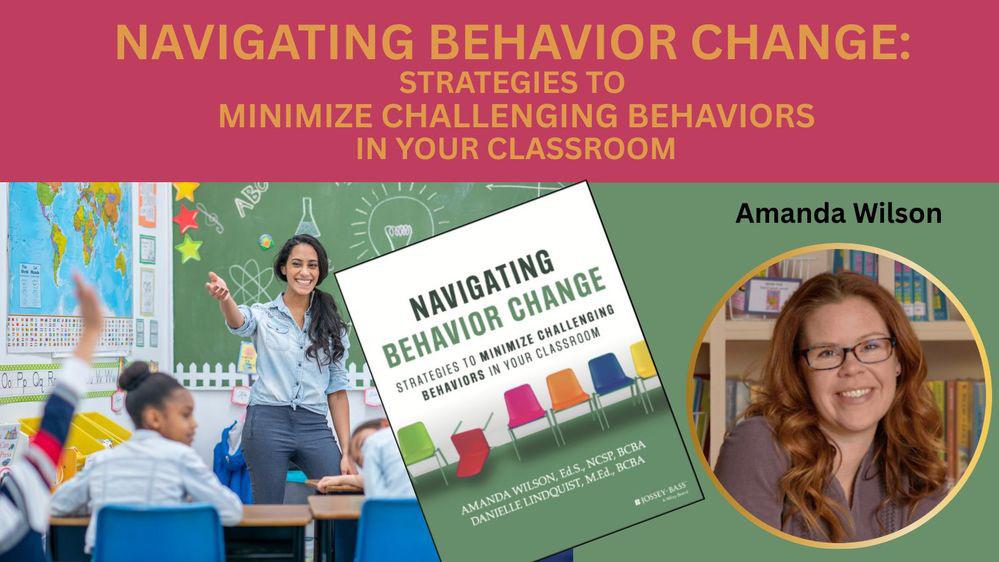
29 30 1 Oct
Igniting Real Change for MultiLingual Learners: Equity and Advocacy in Action presented by Carly Spina
Oct. 16 | 8:30am - 3:00pm
Medinah Shrine Banquets or Online Explore ways to effectively improve your systems for multilingual learners by examining current practices and programs through an equity lens.
MORE INFORMATION
6 7
Leaders of the Class: Teaching
Effective Communication and Collaboration Skills in Your Classroom presented by Maureen Chapman and James Simons
Oct. 22 | 9:00am - 12:00pm Online
In these two interactive sessions, you will apply the principles of leadership development to your academic teaching, exploring tools for teaching the communication and collaboration skills needed for success in your classroom.
13
MORE INFORMATION
Become immersed to harness the power of artificial intelligence to transform curriculum design, planning, and assessment.
MORE INFORMATION
8
Level Up that IEP with Shelley Kenow
Oct. 23 | 9:00am - 12:00pm Online
Whether you are a general or special education teacher, this will help you have a better understanding of how to write and implement IEPs that truly provide FAPE while meeting the unique needs of the child and preparing them for further education, employment, and independent living.
14
MORE INFORMATION
15
Spark Classroom Engagement for Students in the Middle Grades presented by Jen Ciok
Oct. 28 | 9:00am - 12:00pm Live Online or Recording
AI Curriculum Design: Leveraging AI for Dynamic and Brain-Aligned Curriculum Design presented by Steve Oertle
20
21
Oct. 22 | 8:30am - 3:30pm NIU Naperville
22
An examination of the developing adolescent brain and how teachers can collect qualitative data to better understand students’ experience. Simple and practical ways to infuse relevance and meaning into the curriculum.
MORE INFORMATION
29 30 1 Oct
Navigating Behavior Change: Strategies to Minimize Challenging Behaviors in Your Classroom with Amanda Wilson
Oct. 30 | 9:00am - 12:00pm
Live Online or Recording
Take a proactive approach to behavior and help students so you can spend more time teaching, and they can spend more time learning.
MORE INFORMATION
6 7
Vision 365: Reimagining School Improvement
Nov. 5 - Nov. 13 | 9:00am - 12:00pm
Live Online or Recording
Need PD but don't have the time to leave the building?
MORE INFORMATION
13
14
MATH THERAPY Featuring Vanessa Vakharia
Dec. 3 | 9:00am - 3:00pm
NIU Naperville
In this workshop, you’ll learn how to spot the signs of math anxiety and avoidance, and—more importantly— how to heal them.
Empowering Visionary Curriculum Leadership Cohort
Dec. 9 - April 21 | 9:00am - 3:00pm 10701 S. Kilpatrick Ave
Explore learning with education leaders who deliver valid research-based learning approaches.
MORE INFORMATION
8
Calling All Coaches! A Deep Dive into Student-Centered Coaching Cycles with Diane Sweeney
Dec. 16 | 8:30am - 3:00pm
NIU Naperville, Live Online or Recording Take a deep dive into student-centered coaching cycles.
MORE INFORMATION
15
22
20
MORE INFORMATION
21
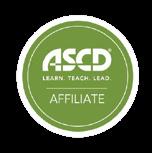

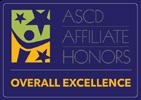
“To build the capacity of educational leaders to enhance the quality of teaching and learning”
President—Amy Warke (Bolingbrook)
President-Elect—Amy MacCrindle (Huntley Community SD158)
Past-President—Scott England (University of Maryland Eastern Shore)
Treasurer—Sarah Cacciatore (Mundelein SDs 75 & 120)
Secretary—Andrew Lobdell (Lena-Winslow SD 202)
Membership and Partnerships
Denise Makowski (Chicago)
Amie Corso Reed (O'Fallon SD 90)
Communications and Publications
Belinda Veillon (Nippersink 2 & Richmond Burton CHSD 157)
Jacquie Duginske (McHenry SD15)
Advocacy and Influence
Richard Lange (National Louis University)
Brenda Mendoza (West Aurora SD 129)
Program Development
Jamie Bajer (ROE 9), Heather Bowman (Washington GSD 52), Scott England (University of Maryland Eastern Shore), Amy MacCrindle (Huntley CSD 158), Terry Mootz (Crystal Lake), Amie Reed (O'Fallon SD 90), Dee Ann Schnautz (SIU), Belinda Veillon Nippersink SD 2, Richmond Burton CHS 157) Amy Warke (Bolingbrook), Doug Wood (Springfield)
JOIN OUR ONLINE COMMUNITY!
Get involved with our social media:
